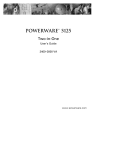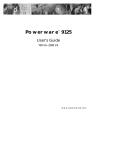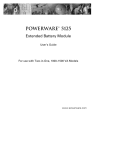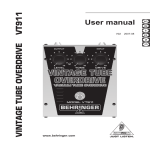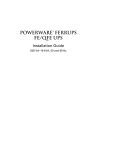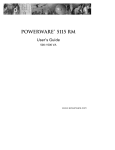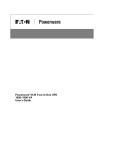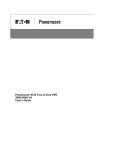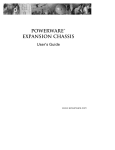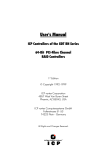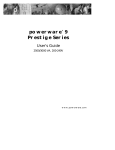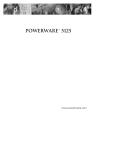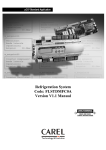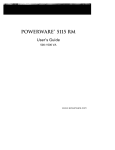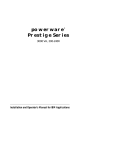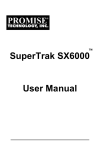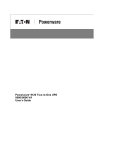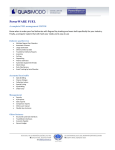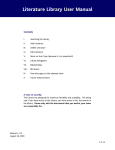Download powerware® 9 Prestige Series
Transcript
02/20/2001
®
powerware 9
Prestige Series
User’s Guide
600 VA - 1800 VA
www.powerware.com
FCC Statement
The Powerware9 9 Prestige Series UPS configurations vary. Some configurations may or may not be classified by the
Federal Communications Commission (FCC). If your Prestige unit is classified by these standards, the corresponding
information applies:
Class A
NOTE This equipment has been tested and found to comply with the limits for a Class A digital device, pursuant to
Part 15 of the FCC Rules. These limits are designed to provide reasonable protection against harmful interference when
the equipment is operated in a commercial environment. This equipment generates, uses, and can radiate radio frequency
energy and, if not installed and used in accordance with the instruction manual, may cause interference to radio
communications. Operation of this equipment in a residential area is likely to cause interference in which case the user
will be required to correct the interference at his own expense.
Class B
NOTE This equipment has been tested and found to comply with the limits for a Class B digital device, pursuant to
Part 15 of the FCC Rules. These limits are designed to provide reasonable protection against harmful interference when
the equipment is operated in a residential installation. This equipment generates, uses, and can radiate radio frequency
energy and, if not installed and used in accordance with instructions, may cause harmful interference to radio
communications. However, there is no guarantee that interference will not occur in a particular installation. If this
equipment does cause harmful interference to radio or television reception, which can be determined by turning the
equipment off and on, the user is encouraged to try to correct the interference by one or more of the following measures:
Reorient or relocate the receiving antenna.
Increase the separation between the equipment and receiver.
Connect the equipment into an outlet on a circuit different from that to which the receiver is connected.
Consult the dealer or an experienced radio/TV technician for help.
:
:
:
:
European EMC Statement
Some configurations are classified under EN50091-2 as “Class-A UPS for Unrestricted Sales Distribution.” For these
configurations, the following applies:
WARNING This is a Class A-UPS Product. In a domestic environment, this product may cause radio interference, in
which case, the user may be required to take additional measures.
EC Declaration of Conformity
Units that are labeled with a CE mark comply with the following EU directives:
73/23/EEC
93/68/EEC
89/336/EEC
Council Directive on equipment designed for use within certain voltage limits.
Amending Directive 73/23/EEC.
Council Directive relating to electromagnetic compatibility.
The EC Declaration of Conformity is available upon request for products with a CE mark. For copies of the EC
Declaration of Conformity, contact:
Powerware Corporation
Koskelontie 13
FIN-02920 Espoo
Finland
Phone: +358-9-452661
Fax: +358-9-452-66395
Powerware, PowerPass, Powercare, OnliNet, and OnliSafe are registered trademarks of Powerware Corporation.
IBM and AS/400 are registered trademarks of International Business Machines Corp.
Novell is a registered trademark of Novell, Inc.
3Com is a registered trademark of 3Com Corporation.
.
Copyright 1993-99 Powerware Corporation, Raleigh, North Carolina, U.S.A. All rights reserved. No part of this
document may be reproduced in any way without the express written approval of Powerware Corporation.
120V MODEL QUICK INSTALLATION
1
2
230V MODEL QUICK INSTALLATION
NOTE For 208, 220, or 240V models, follow the instructions for changing the output voltage on
page 32.
1
2
TABLE OF CONTENTS
1 Introduction . . . . . . . . . . . . . . . . . . . . . . . . . . . . . . . . . . . . . . . . . . . . . . . . . . . . 1
UPS Model and Battery Configurations . . . . . . . . . . . . . . . . . . . . . . . . . . . . . . . . . . . . . . . . . . . . . .
Load Requirements . . . . . . . . . . . . . . . . . . . . . . . . . . . . . . . . . . . . . . . . . . . . . . . . . . . . . . . . .
Battery Times . . . . . . . . . . . . . . . . . . . . . . . . . . . . . . . . . . . . . . . . . . . . . . . . . . . . . . . . . . . . .
Special Symbols . . . . . . . . . . . . . . . . . . . . . . . . . . . . . . . . . . . . . . . . . . . . . . . . . . . . . . . . . . . . . .
2
2
3
7
2 Safety Warnings . . . . . . . . . . . . . . . . . . . . . . . . . . . . . . . . . . . . . . . . . . . . . . . . . 9
Sikkerhedsanvisninger . . . . . . . . . . . . . . . . . . . . . . . . . . . . . . . . . . . . . . . . . . . . . . . . . . . . . . . . .
Belangrijke Veiligheidsinstructies . . . . . . . . . . . . . . . . . . . . . . . . . . . . . . . . . . . . . . . . . . . . . . . . . .
Tarkeita Turvaohjeita . . . . . . . . . . . . . . . . . . . . . . . . . . . . . . . . . . . . . . . . . . . . . . . . . . . . . . . . . .
Consignes de sécurité . . . . . . . . . . . . . . . . . . . . . . . . . . . . . . . . . . . . . . . . . . . . . . . . . . . . . . . . . .
Sicherheitswarnungen . . . . . . . . . . . . . . . . . . . . . . . . . . . . . . . . . . . . . . . . . . . . . . . . . . . . . . . . .
ÐñïåéäïðïéÞóåéò ÁóöÜëåéáò . . . . . . . . . . . . . . . . . . . . . . . . . . . . . . . . . . . . . . . . . . . . . . . .
Avvisi di sicurezza . . . . . . . . . . . . . . . . . . . . . . . . . . . . . . . . . . . . . . . . . . . . . . . . . . . . . . . . . . . . .
Viktig Sikkerhetsinformasion . . . . . . . . . . . . . . . . . . . . . . . . . . . . . . . . . . . . . . . . . . . . . . . . . . . . .
Regulamentos de Segurança . . . . . . . . . . . . . . . . . . . . . . . . . . . . . . . . . . . . . . . . . . . . . . . . . . . . .
Предупреждения по мерам безопасности . . . . . . . . . . . . . . . . . . . . . . . . . . . . . . . . . . .
Advertencias de Seguridad . . . . . . . . . . . . . . . . . . . . . . . . . . . . . . . . . . . . . . . . . . . . . . . . . . . . . .
Säkerhetsföreskrifter . . . . . . . . . . . . . . . . . . . . . . . . . . . . . . . . . . . . . . . . . . . . . . . . . . . . . . . . . .
10
12
13
15
16
18
20
21
23
24
26
27
3 Installation . . . . . . . . . . . . . . . . . . . . . . . . . . . . . . . . . . . . . . . . . . . . . . . . . . . . . 29
Unpacking and Inspection . . . . . . . . . . . . . . . . . . . . . . . . . . . . . . . . . . . . . . . . . . . . . . . . . . . . . . .
UPS and Battery Cabinet Storage . . . . . . . . . . . . . . . . . . . . . . . . . . . . . . . . . . . . . . . . . . . . . . .
UPS and Battery Cabinet Installation . . . . . . . . . . . . . . . . . . . . . . . . . . . . . . . . . . . . . . . . . . . . . . .
UPS Startup for 120V Models . . . . . . . . . . . . . . . . . . . . . . . . . . . . . . . . . . . . . . . . . . . . . . . . . .
UPS Startup for 208V-240V Models . . . . . . . . . . . . . . . . . . . . . . . . . . . . . . . . . . . . . . . . . . . . . .
Troubleshooting Tips . . . . . . . . . . . . . . . . . . . . . . . . . . . . . . . . . . . . . . . . . . . . . . . . . . . . . . . . . . .
29
29
29
31
32
34
4 UPS Operation . . . . . . . . . . . . . . . . . . . . . . . . . . . . . . . . . . . . . . . . . . . . . . . . . . 35
UPS Front Panel . . . . . . . . . . . . . . . . . . . . . . . . . . . . . . . . . . . . . . . . . . . . . . . . . . . . . . . . . . . . . .
Operating Modes . . . . . . . . . . . . . . . . . . . . . . . . . . . . . . . . . . . . . . . . . . . . . . . . . . . . . . . . . . . . .
Normal Mode . . . . . . . . . . . . . . . . . . . . . . . . . . . . . . . . . . . . . . . . . . . . . . . . . . . . . . . . . . . . .
Bypass Mode . . . . . . . . . . . . . . . . . . . . . . . . . . . . . . . . . . . . . . . . . . . . . . . . . . . . . . . . . . . . .
Battery Mode . . . . . . . . . . . . . . . . . . . . . . . . . . . . . . . . . . . . . . . . . . . . . . . . . . . . . . . . . . . . .
Powerware® 9 Prestige Series User’s Guide (600 VA - 1800 VA) : www.powerware.com
35
36
36
37
37
i
Table of Contents
Diagnostics . . . . . . . . . . . . . . . . . . . . . . . . . . . . . . . . . . . . . . . . . . . . . . . . . . . . . . . . . . . . . . . . .
Battery Test on Demand . . . . . . . . . . . . . . . . . . . . . . . . . . . . . . . . . . . . . . . . . . . . . . . . . . . . . .
Battery Start . . . . . . . . . . . . . . . . . . . . . . . . . . . . . . . . . . . . . . . . . . . . . . . . . . . . . . . . . . . . . . . .
UPS Shutdown . . . . . . . . . . . . . . . . . . . . . . . . . . . . . . . . . . . . . . . . . . . . . . . . . . . . . . . . . . . . . . .
Changing the Output Voltage . . . . . . . . . . . . . . . . . . . . . . . . . . . . . . . . . . . . . . . . . . . . . . . . . . . . .
Using the PowerPass . . . . . . . . . . . . . . . . . . . . . . . . . . . . . . . . . . . . . . . . . . . . . . . . . . . . . . . . . .
Using Maintenance Bypass . . . . . . . . . . . . . . . . . . . . . . . . . . . . . . . . . . . . . . . . . . . . . . . . . . . .
38
38
39
39
39
40
41
5 Communication . . . . . . . . . . . . . . . . . . . . . . . . . . . . . . . . . . . . . . . . . . . . . . . . . 45
Initial Communications Settings . . . . . . . . . . . . . . . . . . . . . . . . . . . . . . . . . . . . . . . . . . . . . . . . . . .
Front Panel Communications Access . . . . . . . . . . . . . . . . . . . . . . . . . . . . . . . . . . . . . . . . . . . . . . .
UPS Serial Communications Menu . . . . . . . . . . . . . . . . . . . . . . . . . . . . . . . . . . . . . . . . . . . . . . . . .
Power Management Software . . . . . . . . . . . . . . . . . . . . . . . . . . . . . . . . . . . . . . . . . . . . . . . . . . . .
UPS Communications Interface Port . . . . . . . . . . . . . . . . . . . . . . . . . . . . . . . . . . . . . . . . . . . . . . . .
Communications Mode Reference Chart . . . . . . . . . . . . . . . . . . . . . . . . . . . . . . . . . . . . . . . . . . . . .
45
46
48
51
52
53
6 Specifications . . . . . . . . . . . . . . . . . . . . . . . . . . . . . . . . . . . . . . . . . . . . . . . . . . 55
Prestige UPS Model Specifications . . . . . . . . . . . . . . . . . . . . . . . . . . . . . . . . . . . . . . . . . . . . . . . . 55
Prestige UPS Physical Specifications . . . . . . . . . . . . . . . . . . . . . . . . . . . . . . . . . . . . . . . . . . . . . . . 56
Prestige UPS Technical Specifications . . . . . . . . . . . . . . . . . . . . . . . . . . . . . . . . . . . . . . . . . . . . . . 56
7 Troubleshooting . . . . . . . . . . . . . . . . . . . . . . . . . . . . . . . . . . . . . . . . . . . . . . . . . 57
Resetting the UPS . . . . . . . . . . . . . . . . . . . . . . . . . . . . . . . . . . . . . . . . . . . . . . . . . . . . . . . . . . . . 59
Silencing the Alarm . . . . . . . . . . . . . . . . . . . . . . . . . . . . . . . . . . . . . . . . . . . . . . . . . . . . . . . . . . . 59
Service and Support . . . . . . . . . . . . . . . . . . . . . . . . . . . . . . . . . . . . . . . . . . . . . . . . . . . . . . . . . . . 60
Index . . . . . . . . . . . . . . . . . . . . . . . . . . . . . . . . . . . . . . . . . . . . . . . . . . . . . . . . . 61
ii
Powerware® 9 Prestige Series User’s Guide (600 VA - 1800 VA) : www.powerware.com
CHAPTER
1
INTRODUCTION
Congratulations on the purchase of your Powerware9 9 Prestige Series
uninterruptible power system (UPS). The Prestige UPS meets the
toughest measures of superior design and manufacturing, including
ISO 9001. You now own the most reliable power protection available.
The Prestige provides a steady, well-regulated power supply for your
computing and communications equipment, while protecting it from the
frequent irregularities that are inherent in commercially available power.
Voltage spikes, power surges, brownouts, and power failures have the
potential to corrupt critical data, destroy unsaved work sessions, and in
some instances, damage expensive hardware.
With the Prestige, you can safely eliminate the effects of electrical line
disturbances and guard the integrity of your systems and equipment.
The optional PowerPass9 has a Maintenance Bypass feature that supplies
power to your equipment even when the UPS electronics are removed
for maintenance or upgrades. Figure 1 shows the Prestige UPS.
Figure 1. Prestige UPS
Powerware® 9 Prestige Series User’s Guide (600 VA - 1800 VA) : www.powerware.com
1
Introduction
UPS Model and Battery Configurations
This UPS is designed to work with single-phase, three-wire, AC power
sources. There are two important considerations when selecting the UPS
model and battery configuration to properly safeguard your equipment:
:
Load requirements
:
Battery times
Load Requirements
The load is the equipment to be protected by the UPS. Select the UPS
model that meets the power consumption requirements of the load in
volt-amperes (VA). The total load VA should not exceed the UPS VA
rating. To determine the total load requirements:
1. Obtain the load ratings from either the nameplate or operator’s
manual of the equipment to be protected by the UPS. The
ratings are listed in either watts (W), amperes or amperes
max (A), or volt-amperes.
2. If the rating is in watts, multiply by 1.4 to obtain the VA
requirement (this is the typical relationship between watts and
volt-ampere ratings in most computing equipment). However,
in some new computing equipment, the power supply is
power-factor corrected and the watts rating equals the VA
requirement. Check with the manufacturer to determine
applicability.
If the rating is in amperes or amperes max, multiply by the
input voltage to obtain the VA requirement.
2
Powerware® 9 Prestige Series User’s Guide (600 VA - 1800 VA) : www.powerware.com
Introduction
3. Add all of the resultant VA ratings together to obtain the total
load requirements of the equipment to be protected (see
Figure 2). If the load consists of the power-factor corrected
supplies, it is recommended to use total watts for the load
requirements.
COMPUTER
MONITOR
EXTERNAL
MODEM
100 WATTS
2 AMPS
50 VA
100 WATTS x 1.4 = 140 VA
2 AMPERES x 120 = 240 VA
or 1 AMPERE x 240 = 240 VA
50 VA
140 VA + 240 VA + 50 VA = 430 VA (Total Load Requirements)
Figure 2. Volt-Amperes Calculation Example
If the total load requirements of the equipment exceeds the capacity of
the UPS, you must either reduce the number of pieces of equipment, or
use a UPS with a larger load capacity.
When deciding on which pieces of equipment to remove from the UPS,
select equipment that has a lower priority for power protection.
Computers, monitors, and modems typically have a higher priority
because they could be processing or transmitting data when a power
outage occurs.
Battery Times
During a power failure, the UPS battery supplies power to your
equipment, providing time to complete computing activities prior to
UPS shutdown. The duration of this time period is directly related to the
UPS battery configuration. By adding battery cabinets (EXT models
only), you can customize the UPS to provide enough battery time for
normal processing activities.
The rating label on the UPS rear panel shows the model number. Model
numbers with a “P2” are EXT units; numbers with “HV” are high
voltage units (208 - 240V models). The following tables show the
average battery times by product model.
Powerware® 9 Prestige Series User’s Guide (600 VA - 1800 VA) : www.powerware.com
3
Introduction
Prestige 600 - 1500 VA, 120V Models
Load
(VA) at
.7 PF*
Load
(W)
650
800
1000
750 EXT
1000 EXT
1250 EXT
1500 EXT
200
140
37
37
37
68
68
68
68
400
280
22
22
22
32
32
32
32
600
420
12
12
12
20
20
20
20
8
15A
14
14
14
11
11
11
8
8
800
560
1000
700
1250
875
1500
1050
Load
(VA) at
.7 PF*
Load
(W)
200
Internal UPS Batteries (Rounded to the Nearest Minute)
8
6
6
External Battery Cabinet Configurations for EXT Models
1/2
Cabinet
1
Cabinet
1 1/2
Cabinets
2
Cabinets
2 1/2
Cabinets
3
Cabinets
3 1/2
Cabinets
4
Cabinets
140
143
216
290
364
438
513
589
663
400
280
69
115
158
198
239
280
320
362
600
420
43
73
105
137
165
194
221
249
750
525
33
56
80
106
134
156
178
202
1000
700
23
39
57
75
95
114
135
151
1250
875
17
30
42
56
70
86
102
118
1500
1050
14
23
32
43
55
67
78
91
*Typical Power Factor (PF); A750 VA, 525W
4
Powerware® 9 Prestige Series User’s Guide (600 VA - 1800 VA) : www.powerware.com
Introduction
Prestige 600 - 1250 VA, 208 - 240V Models
Load
(VA)
at
.7 PF*
Load
(W)
600
800
1000
800
EXT
1000
EXT
1250
EXT
200
140
33
33
33
56
56
56
400
280
21
21
21
29
29
29
600
420
11
11
11
19
19
19
800
560
7
7
13
13
13
1000
700
10
10
1250
875
Load
(VA)
at
.7 PF*
Load
(W)
200
Internal UPS Batteries (Rounded to the Nearest Minute)
6
8
External Battery Cabinet Configurations for EXT Models
1/2
Cabinet
1
Cabinet
1 1/2
Cabinets
2
Cabinets
2 1/2
Cabinets
3
Cabinets
3 1/2
Cabinets
4
Cabinets
140
133
203
274
346
418
491
564
637
400
280
70
117
159
201
243
285
328
371
600
420
46
76
110
141
171
200
230
260
800
560
33
55
79
105
132
153
176
199
1000
700
25
42
61
81
102
124
147
161
1250
875
19
32
46
61
77
94
111
129
*Typical Power Factor (PF)
Powerware® 9 Prestige Series User’s Guide (600 VA - 1800 VA) : www.powerware.com
5
Introduction
Prestige 1500 - 1800 VA, 208 - 240V Models
UPS with External Battery Cabinet Configurations (Rounded to the Nearest Minute)
Load
(VA)
at
.7 PF*
Load
(W)
Internal
UPS
Battery
1/2
Cabinet
1
Cabinet
200
140
59
128
194
260
327
393
460
527
595
400
280
29
64
107
149
186
224
263
302
339
600
420
19
42
71
102
135
161
189
217
244
800
560
14
32
52
76
100
125
148
169
191
1000
700
11
24
41
59
77
98
119
138
156
1250
900
8
19
32
45
59
76
92
108
125
1500
1050
7
14
25
36
48
60
73
86
101
1800
1200
5
12
20
29
38
48
59
69
80
1 1/2
2
2 1/2
3
3 1/2
4
Cabinets Cabinets Cabinets Cabinets Cabinets Cabinets
*Typical Power Factor (PF)
6
Powerware® 9 Prestige Series User’s Guide (600 VA - 1800 VA) : www.powerware.com
Introduction
Special Symbols
The following common symbols may be found on the UPS:
LOAD ON - Press the button with this symbol to energize the
output receptacles (Output On).
LOAD OFF - Press the button with this symbol to de-energize
the output receptacles (Output Off).
SAFETY EARTHING TERMINAL - Indicates the primary safety
ground.
RISK OF ELECTRIC SHOCK - Indicates that a risk of electric
shock is present and the associated warning should be
observed.
CAUTION: REFER TO OPERATOR’S MANUAL - Refer to your
operator’s manual for additional information.
This symbol indicates that the UPS batteries should not be
discarded in the trash. The UPS contains sealed lead
batteries and must be disposed of properly. For battery
replacement or removal, call your Local Distributor or the
Help Desk at one of the telephone numbers on page 60.
Powerware® 9 Prestige Series User’s Guide (600 VA - 1800 VA) : www.powerware.com
7
Introduction
8
Powerware® 9 Prestige Series User’s Guide (600 VA - 1800 VA) : www.powerware.com
CHAPTER
2
SAFETY WARNINGS
IMPORTANT SAFETY INSTRUCTIONS
SAVE THESE INSTRUCTIONS. This manual contains important instructions that you
should follow during installation of the UPS. Please read all instructions before
operating the equipment and save this manual for future reference.
DANGER
This UPS contains LETHAL VOLTAGES. All repairs and service should be performed
by AUTHORIZED SERVICE PERSONNEL ONLY. There are NO USER
SERVICEABLE PARTS inside the UPS.
CAUTION
:
Batteries can present a risk of electrical shock or burn from high short circuit
current. Observe proper precautions.
:
Proper disposal of batteries is required. Refer to your local codes for disposal
requirements.
:
This UPS contains its own energy source (batteries). The output receptacles may
carry live voltage even when the UPS is not connected to an AC supply.
:
Never dispose of batteries in a fire. Batteries may explode when exposed to flame.
:
Never open or mutilate batteries. Released electrolyte is harmful to the skin and
eyes, and may be extremely toxic.
:
Use only the power supply cord provided with this UPS. The power cord is wired in
accordance with National Electrical Code (NEC) specifications. Be sure the wall
outlet to be used with the UPS is wired in accordance with these same
specifications in order to avoid damage to your equipment. Be sure that
overcurrent protection for the AC outlet is provided at the time of installation. Be
sure the input plug is completely inserted into the wall outlet. Use a single-phase,
three-wire, grounded AC outlet only.
:
To reduce the risk of fire or electric shock, install this UPS in a temperature and
humidity controlled, indoor environment, free of conductive contaminants. Ambient
temperature must not exceed 104F (40C). Do not operate near water or
excessive humidity (95% max).
Powerware® 9 Prestige Series User’s Guide (600 VA - 1800 VA) : www.powerware.com
9
Safety Warnings
:
Do not remove or unplug the input cord when the UPS is turned on. This removes
the safety ground from the UPS and the equipment connected to the UPS.
:
To comply with international standards and wiring regulations, the total equipment
connected to the output of this UPS must not have an earth leakage current
greater than 2.75 milliamperes.
:
The wall outlet must be within 2 meters of the equipment and accessible to the
operator. The on/off switch on the UPS does not electrically isolate the internal
parts. Unplug the input cord from the wall outlet when disconnecting the unit for
long periods of time.
:
Please note that the output sockets on the UPS are electrically live whenever the
UPS Output On button is pressed, even if the input cord is disconnected.
Sikkerhedsanvisninger
VIGTIGE SIKKERHEDSANVISNINGER
GEM DISSE ANVISNINGER
DENNE BRUGERVEJLEDNING INDEHOLDER VIGTIGE
SIKKERHEDSANVISNINGER
FARE
Denne UPS indeholder LIVSFARLIG HØJSPÆNDING. Alle reparationer og
vedligeholdelse bør kun udføres af en AUTORISERET SERVICETEKNIKER. Ingen af
UPS’ens indvendige dele kan repareres af brugeren.
ADVARSEL
10
:
Batterier kan udgøre en fare for elektrisk stød eller forbrændinger forårsaget af høj
kortslutningsspænding. De korrekte forholdsregler bør overholdes.
:
Korrekt bortskaffelse af batterier er påkrævet. Overhold gældende lokale regler for
bortskaffelsesprocedurer.
:
Denne UPS indeholder egen energiforsyning (batterier). Udgangsnetstikkene kan
lede strøm, selv når UPS’en ikke er tilsat en AC-energikilde.
:
Skaf dig aldrig af med batterierne ved at brænde dem. Batterierne kan eksplodere
ved åben ild.
:
Batterierne bør aldrig åbnes eller skilles ad. Elektrolyt, der slipper ud, er skadelig
for hud og øjne og kan være overordentlig giftig.
Powerware® 9 Prestige Series User’s Guide (600 VA - 1800 VA) : www.powerware.com
Safety Warnings
:
Brug kun den netledning, som blev leveret med UPS’en. Denne netledning er
tilsluttet ifølge specifikationerne for NEC (National Electrical Code). Sørg for, at
stikket, som skal bruges til UPS’en, er tilsluttet ifølge de samme specifikationer for
at undgå skade på dit udstyr. Sørg for, at der er overstrømsbeskyttelse på
AC-stikket på monteringstidspunktet. Sørg for, at stikket er sat helt ind i
stikkontakten. Brug en enfaset, -treledet AC-kilde, som er jordet.
:
Installér denne UPS i et temperatur- og fugtighedskontrolleret indendørsmiljø, frit
for ledende forureningsstoffer for at formindske risikoen for brand og elektrisk
stød. Rumtemperaturen må ikke overstige 40°C. UPS’en bør ikke betjenes nær
vand eller høj fugtighed (maksimalt 95%).
:
Netledningen må ikke fjernes og stikket må ikke trækkes ud, mens UPS’en er
tændt. Dette fjerner sikkerhedsjorden fra UPS’en og fra det udstyr, der er sat til.
:
I overensstemmelse med internationale normer og bestemmelser for el-installation
må det udstyr, der er forbundet til udgangen af denne UPS, tilsammen ikke
overskride en jordafdelingsspænding på mere end 2,75 milliampere.
:
Stikkontakten må højst være 2 meter fra udstyret og tilgængelig for brugeren.
UPS’ens afbryderkontakt isolerer ikke elektrisk de indvendige dele. Træk derfor
stikket ud af kontakten, hvis enheden er slukket i lang tid ad gangen.
:
Bemærk venligst, at stikkontakterne på UPS’en er strømførende, når knappen UPS
“Output On” er trykket ned, selvom indgangsnedledningen ikke er tilsluttet.
Powerware® 9 Prestige Series User’s Guide (600 VA - 1800 VA) : www.powerware.com
11
Safety Warnings
Belangrijke Veiligheidsinstructies
BELANGRIJKE VEILIGHEIDSINSTRUCTIES
BEWAAR DEZE INSTRUCTIES
DEZE HANDLEIDING BEVAT BELANGRIJKE
VEILIGHEIDSINSTRUCTIES
GEVAAR
Deze UPS bevat LEVENSGEVAARLIJKE ELEKTRISCHE SPANNING. Alle reparaties en
onderhoud dienen UITSLUITEND DOOR ERKEND SERVICEPERSONEEL te worden
uitgevoerd. Er bevinden zich GEEN ONDERDELEN in de UPS die DOOR DE GEBRUIKER
kunnen worden GEREPAREERD.
OPGELET
12
:
Batterijen kunnen gevaar voor elektrische schok of brandwonden veroorzaken als
gevolg van un hoge kortsluitstroom. Volg de desbetreffende aanwijzingen op.
:
De batterijen moeten op de juiste wijze worden opgeruimd. Raadpleeg hiervoor uw
plaatselijke voorschriften.
:
Deze UPS bevat zijn eigen energiebron (batterijen). De uitgangsaansluitingen
kunnen onder spanning staan wanneer de UPS niet op een wisselstroom voeding is
aangesloten.
:
Nooit batterijen in het vuur gooien. De batterijen kunnen ontploffen.
:
Nooit batterijen openen of beschadigen. Vrijkomend elektrolyt is schadelijk voor de
huid en ogen, en kan uiterst giftig zijn.
:
Uitsluitend het elektriciteitssnoer gebruiken dat bij deze UPS wordt geleverd. Het
snoer is volgens de specificaties van de IEC (International Electrical Code) bedraad.
Controleer of wandcontactdoos waarop de UPS wordt aangesloten, volgens deze
zelfde specificaties is bedraad teneinde schade aan uw apparatuur te voorkomen.
Controleer of het wandcontactdoos voldoende is afgezeherd. Controleer of de
voedingsstekker goed in het stopcontact is gestoken. Gebruik uitsluitend een
enkelfasig geaard wandcontactdoos met randaarde.
:
Teneinde de kans op brand of elektrische schok te verminderen dient deze UPS in
een gebouw met temperatuur- en vochtigheidregeling te worden geïnstalleerd,
waar geen geleidende verontreinigingen aanwezig zijn. De omgevingstemperatuur
mag 40EC niet overschrijden. Niet gebruiken in de buurt van water of bij zeer hoge
vochtigheid (max. 95%).
Powerware® 9 Prestige Series User’s Guide (600 VA - 1800 VA) : www.powerware.com
Safety Warnings
:
Verwijder de ingangsnoer niet of haal de stekker van de ingangsnoer er niet uit
terwijl de UPS aan staat. Hierdoor zou de UPS en uw aangesloten apparatuur geen
aardebeveiliging meer hebben.
:
Om aan de internationale normen en bedradingsvoorschriften te voldoen mag de
gehele apparatuur die op de uitgang van deze UPS is aangesloten, geen
aardlekstroom van meer dan 2,75 milliampère hebben.
:
De hoofdvoedingcontactdoos moet zich op minder dan 2 meter van de apparatuur
bevinden en makkelijk bereikbaar zijn voor de gebruiker. De aan/uit-schakelaar op
de UPS biedt geen elektrische isolatie voor de inwendige onderdelen. De stekker
uit de voedingcontactdoos halen wanneer het apparaat voor lange tijd niet wordt
gebruikt.
:
Neem er nota van dat de uitgangaansluit punten op de UPS altijd onder stroom
staan wanneer de belastingschakelaar ( | ) wordt ingedrukt, ongeacht de
aanwezigheid van de voeding.
Tarkeita Turvaohjeita
TÄRKEITÄ TURVAOHJEITA - SUOMI
SÄILYTÄ NÄMÄ OHJEET
TÄMÄ OPAS SISÄLTÄÄ TÄRKEITÄ TURVAOHJEITA
VAARA
Tämä UPS sisältää HENGENVAARALLISIA JÄNNITTEITÄ. Kaikki korjaukset ja huollot
on jätettävä VAIN VALTUUTETUN HUOLTOHENKILÖN TOIMEKSI. UPS ei sisällä
MITÄÄN KÄYTTÄJÄN HUOLLETTAVIA OSIA.
VARO
:
Akusto saattaa aiheuttaa sähköiskun tai syttyä tuleen, jos akusto kytketään
oikosulkuun. Noudata asianmukaisia ohjeita.
:
Akusto täytyy hävittää säädösten mukaisella tavalla. Noudata paikallisia
määräyksiä.
:
Tämä UPS sisältää oman energialähteen (akuston). Ulostuloliittimissä voi olla
jännite, kun UPS ei ole liitettynä verkkojännitteeseen.
:
Älä koskaan heitä akkuja tuleen. Ne voivat räjähtää.
:
Älä avaa tai riko akkuja. Paljastunut elektrolyytti on vahingollinen iholle ja silmille
ja voi olla erittäin myrkyllistä.
Powerware® 9 Prestige Series User’s Guide (600 VA - 1800 VA) : www.powerware.com
13
Safety Warnings
14
:
Käytä vain tämän UPS-laitteen mukana toimitettua virtakaapelia, joka on kytketty
kansallisten määräysten mukaisesti. Varmista, että UPS-laitteen kanssa käytetty
pistorasia on johdotettu näiden samojen määritysten mukaisesti, jotta laitteet
eivät vahingoittuisi. Varmista myös, että asennuksen yhteydessä vaihtovirran
pistorasia varustetaan ylivirtasuojauksella. Työnnä kosketin kokonaan pistorasiaan.
Käytä pelkästään yksivaihteista, kolmijohtoista, maadoitettua verkkopistorasiaa.
:
Vähentääksesi tulipalon ja sähköiskun vaaraa asenna tämä UPS sisätiloihin, joissa
lämpötila ja kosteus on säädettävissä ja joissa ei ole virtaa johtavia
epäpuhtauksia. Ympäristön lämpötila ei saa ylittää 40 C. Älä käytä lähellä vettä ja
vältä kosteita tiloja (95 % maksimi).
:
Älä poista tai irrota sisääntulojohtoa, kun UPS on kytkettynä. Tämä poistaa
turvamaadoituksen UPS-laitteesta ja siihen liitetystä laitteistosta.
:
Kansainväliset normit ja johdotusmääräykset vaativat, että kaikkien tämän
UPS-laitteen ulostulokytkentöjen yhteinen maavuotovirta ei ylitä
2,75 milliampeeria (mA).
:
Päävirtapistokkeen täytyy olla 2 m:n säteellä laitteistosta ja käyttäjän saatavilla.
UPS-laitteen virtakytkin ei erota sisäosia verkkojännitteestä. Irrota
sisääntulopistoke, jos kytket laitteen pois käytöstä pitkähköksi ajaksi.
:
Ota myös huomioon, että UPS-laitteen ulostuloliittimissä on jännite aina kun
painetaan UPSin lähtöteho PÄÄLLÄ -painiketta ( | ), riippumatta siitä, onko
tulokaapeli kytkettynä tai ei.
Powerware® 9 Prestige Series User’s Guide (600 VA - 1800 VA) : www.powerware.com
Safety Warnings
Consignes de sécurité
CONSIGNES DE SÉCURITÉ IMPORTANTES
CONSERVER CES INSTRUCTIONS
CE MANUEL CONTIENT DES CONSIGNES DE SÉCURITÉ
IMPORTANTES
DANGER!
Cet onduleur contient des TENSIONS MORTELLES. Toute opération d’entretien et de
réparation doit être EXCLUSIVEMENT CONFIÉE A UN PERSONNEL QUALIFIÉ AGRÉÉ.
AUCUNE PIÈCE RÉPARABLE PAR L’UTILISATEUR ne se trouve dans l’onduleur.
ATTENTION!
:
Les batteries peuvent présenter un risque de décharge électrique ou de brûlure par
des courts-circuits de haute intensité. Prendre les précautions nécessaires.
:
Une mise au rebut réglementaire des batteries est obligatoire. Consulter les
règlements en vigueur dans votre localité.
:
Cet onduleur renferme sa propre source d’énergie (batteries). Les prises de sortie
peuvent être sous tension même lorsque l’onduleur n’est pas branché sur le
secteur.
:
Ne jamais jeter les batteries au feu. L’exposition aux flammes risque de les faire
exploser.
:
Ne jamais ouvrir ou mutiler des batteries. L’électrolyte dégagé est nuisible à la
peau et aux yeux et peut s’avérer extrêmement toxique.
:
Utiliser uniquement le cordon d’alimentation fourni avec l’onduleur. Ce cordon est
câblé conformément aux spécifications du Code électrique international (CEI).
S’assurer que le câblage de la prise secteur devant être utilisée avec l’onduleur est
lui aussi conforme à ces spécifications pour éviter d’endommager le matériel.
S’assurer que la prise secteur est protégée contre les surcharges au moment de
l’installation. S’assurer que la prise d’entrée est insérée à fond dans la prise
secteur. Utiliser uniquement une prise secteur à trois fils, monophasée et mise à la
terre.
:
Pour réduire les risques d’incendie et de décharge électrique, installer l’onduleur
uniquement à l’intérieur, dans un lieu dépourvu de matériaux conducteurs, où la
température et l’humidité ambiantes sont contrôlées. La température ambiante ne
doit pas dépasser 40 °C. Ne pas utiliser à proximité d’eau ou dans une atmosphère
excessivement humide (95 % maximum).
Powerware® 9 Prestige Series User’s Guide (600 VA - 1800 VA) : www.powerware.com
15
Safety Warnings
:
Ne pas retirer le cordon d’alimentation lorsque l’onduleur est sous tension sous
peine de supprimer la mise à la terre de l’onduleur et du matériel connecté.
:
Afin d’être conforme aux normes et règlements internationaux de câblage, le
courant de fuite à la terre de la totalité du matériel branché sur la sortie de
l’onduleur ne doit pas dépasser 2,75 mA.
:
La prise secteur doit se trouver à moins de 2 m du matériel et être accessible à
l’utilisateur. L’interrupteur de ON/OFF (marche/arrêt) de l’onduleur n’assure pas
l’isolation électrique des pièces internes. Débrancher le cordon d’alimentation de
la prise secteur en cas de déconnexion de l’appareil pendant une période
prolongée.
:
Noter que les prises de sortie de l’onduleur sont sous tension lorsque Output On
buttonest enfoncé, même si le cordon d’alimentation est débranché de la prise
secteur.
Sicherheitswarnungen
WICHTIGE SICHERHEITSANWEISUNGENANLEITUNGEN
AUFBEWAHREN.DIESES HANDBUCH ENTHÄLT WICHTIGE
SICHERHEITSANWEISUNGEN.
WARNUNG
Die USV führt lebensgefährliche Spannungen. Alle Reparatur- und Wartungsarbeiten
sollten nur von Kundendienstfachleuten durchgeführt werden. Die USV enthält keine
vom Benutzer zu wartenden Komponente
VORSICHT!
16
:
Batterien können aufgrund des hohen Kurzschlußstroms Elektroschocks oder
Verbrennungen verursachen. Die entsprechenden Vorsichtsmaßnahmen sind
unbedingt zu beachten.
:
Die Batterien müssen ordnungsgemäß entsorgt werden. Hierbei sind die örtlichen
Bestimmungen zu beachten.en.
:
Diese USV ist mit einer eigenen Energiequelle (Batterie) ausgestattet. An den
Ausgangssteckdosen kann auch dann Spannung anliegen, wenn die USV nicht an
einer Wechselspannungsquelle angeschlossen ist.
:
Batterien niemals verbrennen, da sie explodieren können.
:
Batterien nie öffnen oder anderweitig beschädigen. Der darin enthaltene Elektrolyt
wirkt ätzend auf Haut und Augen. Es besteht Vergiftungsgefahr!
Powerware® 9 Prestige Series User’s Guide (600 VA - 1800 VA) : www.powerware.com
Safety Warnings
:
Nur das Netzkabel verwenden, das dieser USV beiliegt. Dieses Kabel ist gemäß
den Spezifikationen des International Electrical Code (IEC) verdrahtet.
Sicherstellen, daß die Wandsteckdose, die für die USV verwendet wird, gemäß
den selben Spezifikationen verdrahtet ist, um eine eschädigung der Geräte zu
vermeiden. Sicherstellen, daß bei Installation ein Überstromschutz für die
Wechselstromsteckdose vorhanden ist. Sicherstellen, daß der Eingangsstecker
vollständig in die Wandsteckdose eingesteckt wurde. Nur eine einphasige,
geerdete Dreileiter-Wechselstromsteckdose verwenden.
:
Um die Brand- oder Elektroschockgefahr zu verringern, diese USV nur in Gebäuden
mit kontrollierter Temperatur und Luftfeuchtigkeit installieren, in denen keine
leitenden Schmutzstoffen vorhanden sind. Die Umgebungstemperatur darf 40EC
nicht übersteigen. Die USV nicht in der Nähe von Wasser oder in extrem hoher
Luftfeuchtigkeit (max. 95 %) betreiben.
:
Das Eingangskabel nicht entfernen oder abziehen, während die USV eingeschaltet
ist, weil hierdurch die Sicherheitserdung von der USV und den daran
angeschlossenen Geräten entfernt wird.
:
Um internationale Normen und Verdrahtungsvorschriften zu erfüllen, dürfen die an
den Ausgang dieser USV angeschlossenen Geräte zusammen einen
Erdschlußstrom von insgesamt 2,75 Milliampere nicht überschreiten.
:
Die Netzsteckdose, die zur Hauptversorgung verwendet wird, darf sich nicht weiter
als 2 Meter vom Gerät weg befinden und muß für den Bediener erreichbar sein.
Der Ein-/Aus-Schalter der USV bietet keine elektrische Isolation der internen Teile.
Wenn das Gerät längere Zeit nicht benutzt wird, sollte es von der Netzsteckdose
abgezogen werden.
:
Beachten, daß die Ausgangssteckdosen auf der USV jedesmal Strom führen, wenn
der Belastungsschalter ( | ) gedrückt wird, ungeachtet dessen, ob die USV mit
Strom versorgt wird.
Powerware® 9 Prestige Series User’s Guide (600 VA - 1800 VA) : www.powerware.com
17
Safety Warnings
ÐñïåéäïðïéÞóåéò ÁóöÜëåéáò
ÓÇÌÁÍÔÉÊÅÓ ÏÄÇÃÉÅÓ ÁÓÖÁËÅÉÁÓ
ÖÕËÁÎÔÅ ÁÕÔÅÓ ÔÉÓ ÏÄÇÃÉÅÓ
ÔÏ ÐÁÑÏÍ ÅÃ×ÅÉÑÉÄÉÏ ÐÅÑÉÅ×ÅÉ ÓÇÌÁÍÔÉÊÅÓ
ÏÄÇÃÉÅÓ ÁÓÖÁËÅÉÁÓ
ÊÉÍÄÕÍÏÓ
Áõôü ôï UPS ðåñéÝ÷åé ÈÁÍÁÔÇÖÏÑÁ ÔÁÓÇ. ¼ëåò ïé åðéóêåõÝò êáé ïé
óõíôçñÞóåéò ðñÝðåé íá ãßíïíôáé ÌÏÍÏ ÁÐÏ ÅÎÏÕÓÉÏÄÏÔÇÌÅÍÏ ÃÉÁ
ÔÇ ÓÕÍÔÇÑÇÓÇ ÐÑÏÓÙÐÉÊÏ. Ôï UPS ÄÅÍ ÐÅÑÉÅ×ÅÉ ÊÁÍÅÍÁ
ÅÎÁÑÔÇÌÁ ÐÏÕ ÍÁ ÌÐÏÑÅÉ ÍÁ ÅÐÉÓÊÅÕÁÓÔÅÉ ÁÐÏ ÔÏ ×ÑÇÓÔÇ.
:
:
:
:
:
:
18
ÐÑÏÓÏ×Ç
Ïé óõóóùñåõôÝò ìðïñåß íá ðñïêáëÝóïõí çëåêôñïðëçîßá Þ Ýãêáõìá
áðü õøçëü ñåýìá âñá÷õêõêëþìáôïò. ËáìâÜíåôå ôéò êáôÜëëçëåò
ðñïöõëÜîåéò.
Áðáéôåßôáé óùóôÞ äéÜèåóç ôùí óõóóùñåõôþí. Äåßôå ôïõò ôïðéêïýò
êáíïíéóìïýò ðïõ áöïñïýí ôéò áðáéôÞóåéò äéÜèåóÞò ôïõò.
Ôï óõãêåêñéìÝíï UPS ðåñéÝ÷åé ôç äéêÞ ôïõ ðçãÞ åíÝñãåéáò
(óõóóùñåõôÝò). Ïé ñåõìáôïäüôåò åîüäïõ ìðïñåß íá Ý÷ïõí åíåñãü ôÜóç
áêüìç êáé üôáí ôï UPS äåí åßíáé óõíäåäåìÝíï óå ðçãÞ
åíáëëáóóüìåíïõ ñåýìáôïò (AC).
ÐïôÝ ìçí ðåôÜôå ôïõò óõóóùñåõôÝò óôç öùôéÜ, ãéáôß ìðïñåß íá
åêñáãïýí.
ÐïôÝ ìçí áíïßãåôå Þ êáôáóôñÝöåôå ôïõò óõóóùñåõôÝò. Ï
çëåêôñïëýôçò ðïõ èá áðåëåõèåñùèåß ìðïñåß íá ðñïêáëÝóåé âëÜâç óôï
äÝñìá êáé ôá ìÜôéá, êáé ìðïñåß íá åßíáé åîáéñåôéêÜ ôïîéêüò.
×ñçóéìïðïéåßôå ìüíï ôï êáëþäéï ôñïöïäïóßáò ðïõ ðáñÝ÷åôáé ìáæß ìå ôï
UPS. Ôï êáëþäéï áõôü åßíáé êáôáóêåõáóìÝíï óýìöùíá ìå ôéò
ðñïäéáãñáöÝò ôïõ Åèíéêïý Çëåêôñéêïý Êþäéêá (National Electrical
Code) (NEC). Âåâáéùèåßôå üôé ç åíôïé÷éóìÝíç ðñßæá ðïõ ðñüêåéôáé íá
÷ñçóéìïðïéÞóåôå ìå ôï UPS åßíáé êáëùäéùìÝíç óýìöùíá ìå ôéò ßäéåò
ðñïäéáãñáöÝò, þóôå íá áðïöåõ÷èåß ôõ÷üí âëÜâç óôïí åîïðëéóìü óáò.
Âåâáéùèåßôå üôé õðÜñ÷åé óýóôçìá ðñïóôáóßáò áðü õðåñÝíôáóç ãéá ôçí
ðñßæá åíáëëáóóüìåíïõ ñåýìáôïò (AC) ôçí þñá ôçò åãêáôÜóôáóçò.
Âåâáéùèåßôå üôé ï ñåõìáôïëÞðôçò åéóüäïõ Ý÷åé ôïðïèåôçèåß óùóôÜ óôçí
ðñßæá ôïß÷ïõ. ×ñçóéìïðïéÞóôå ìüíï ìïíïöáóéêÞ, ôñéóýñìáôç, ãåéùìÝíç
ðñßæá AC.
Powerware® 9 Prestige Series User’s Guide (600 VA - 1800 VA) : www.powerware.com
Safety Warnings
:
:
:
:
:
Ãéá íá ìåéþóåôå ôïí êßíäõíï ðõñêáãéÜò Þ çëåêôñïðëçîßáò,
åãêáôáóôÞóôå ôï óõãêåêñéìÝíï UPS óå åóùôåñéêü ÷þñï ìå
åëåã÷üìåíç èåñìïêñáóßá êáé õãñáóßá, ï ïðïßïò íá ìçí ðåñéÝ÷åé
áãþãéìá õëéêÜ. Ç èåñìïêñáóßá ðåñéâÜëëïíôïò äåí ðñÝðåé íá
îåðåñíÜåé ôïõò 40° C. Ìç ÷ñçóéìïðïéåßôå ôï UPS êïíôÜ óå íåñü Þ
õðåñâïëéêÞ õãñáóßá (ìÝãéóôç ôéìÞ: 95%).
Ìçí âãÜæåôå áðü ôçí ðñßæá ôï êáëþäéï ôñïöïäïóßáò üôáí ôï UPS åßíáé
áíïé÷ôü. Ì áõôü ôïí ôñüðï áöáéñåßôå ôç ãåßùóç áóöáëåßáò áðü ôï
UPS êáé áðü ôïí åîïðëéóìü ðïõ åßíáé óõíäåäåìÝíïò ìå ôï UPS.
Ãéá íá óõìöùíåß ìå ôá äéåèíÞ ðñüôõðá êáé ôïõò êáíïíéóìïýò
êáëùäßùóçò, ôï ñåýìá äéáññïÞò ðñïò ôç ãç ïëüêëçñïõ ôïõ åîïðëéóìïý,
ðïõ åßíáé óõíäåäåìÝíïò ìå ôçí Ýîïäï ôïõ óõãêåêñéìÝíïõ UPS, äåí
ðñÝðåé íá åßíáé ìåãáëýôåñï áðü 2,75 mA.
Ç ðñßæá ôïß÷ïõ äåí ðñÝðåé íá âñßóêåôáé óå áðüóôáóç ìåãáëýôåñç áðü
2 ìÝôñá áðü ôïí åîïðëéóìü êáé ðñÝðåé íá åßíáé ðñïóðåëÜóéìç óôï
÷ñÞóôç. Ï äéáêüðôçò on/off ôïõ UPS äåí áðïìïíþíåé çëåêôñéêÜ ôá
åóùôåñéêÜ ìÝñç. ¼ôáí áðïóõíäÝåôå ôç ìïíÜäá ãéá ìåãÜëá ÷ñïíéêÜ
äéáóôÞìáôá, âãÜæåôå ôï êáëþäéï åéóüäïõ áðü ôçí ðñßæá.
Óçìåéþóôå üôé ïé õðïäï÷Ýò åîüäïõ ôïõ UPS âñßóêïíôáé õðü åíåñãü
ôÜóç üðïôå åßíáé ðáôçìÝíï ôï ðëÞêôñï Eîïäïò ÅíåñãïðïéçìÝíç ( ),
áêüìç êáé áí ôï êáëþäéï ôñïöïäïóßáò åßíáé áðïóõíäåäåìÝíï.
Powerware® 9 Prestige Series User’s Guide (600 VA - 1800 VA) : www.powerware.com
|
19
Safety Warnings
Avvisi di sicurezza
IMPORTANTI ISTRUZIONI DI SICUREZZA
CONSERVARE QUESTE ISTRUZIONI
QUESTO MANUALE CONTIENE IMPORTANTI ISTRUZIONI DI
SICUREZZA
PERICOLO
la TENSIONE contenuta in questo gruppo statico di continuità è LETALE. Tutte le
operazioni di riparazione e di manutenzione devono essere effettuate
ESCLUSIVAMENTE DA PERSONALE TECNICO AUTORIZZATO. All’interno del gruppo
statico di continuità NON vi sono PARTI RIPARABILI DALL’UTENTE.
ATTENZIONE
20
:
le batterie possono presentare rischio di scossa elettrica o di ustioni provocate da
alta corrente dovuta a corto circuito. Osservare le apposite istruzioni.
:
le batterie devono essere smaltite in modo corretto. Per i requisiti di smaltimento
fare riferimento alle disposizioni locali.
:
questo gruppo statico di continuità contiene una fonte di energia autonoma (le
batterie). Le prese di uscita possono condurre tensione energizzata quando il
gruppo statico di continuità non è collegato con una fonte di alimentazione a
corrente alternata.
:
non gettare mai le batterie nel fuoco poichè potrebbero esplodere se esposte alle
fiamme.
:
mai aprire nè mutilare le batterie poichè l’elettrolita da esse rilasciato è nocivo
alla cute e agli occhi e può essere altamente tossico.
:
usare esclusivamente il cavo di alimentazione in dotazione con il gruppo statico di
continuità. Il cavo di alimentazione è cablato in conformità con le specifiche del
Codice Elettrico Internazionale (IEC). Assicurarsi che la presa a muro nella quale si
deve inserire il gruppo statico di continuità sia cablata in conformità con le
medesime specifiche onde evitare di danneggiare l’apparecchiatura. Accertarsi che
al momento dell’installazione la presa a corrente alternata sia protetta contro le
sovracorrenti. Assicurarsi che la spina di ingresso sia completamente inserita nella
presa a muro. Usare esclusivamente una presa a corrente alternata monofase, a
tre fili, collegata a terra.
Powerware® 9 Prestige Series User’s Guide (600 VA - 1800 VA) : www.powerware.com
Safety Warnings
:
per ridurre il rischio di incendio o di scossa elettrica, installare il gruppo statico di
continuità in un ambiente interno a temperatura ed umidità controllata, privo di
agenti contaminanti conduttivi. La temperatura ambiente non deve superare i
40EC. Non utilizzare l’unità in prossimità di acqua o in presenza di umidità
eccessiva (95% max).
:
non rimuovere nè scollegare il cavo di ingresso quando il gruppo statico di
continuità è acceso poichè in tal modo si disattiverebbe il collegamento a terra di
sicurezza del gruppo statico di continuità e dell’apparecchiatura ad esso collegata.
:
per conformità con gli standard internazionali e con le norme in merito al
cablaggio, tutta l’apparecchiatura collegata con l’uscita del gruppo statico di
continuità non deve avere una corrente di dispersione di terra superiore a
2,75 milliampere.
:
la presa di alimentazione principale non deve trovarsi a oltre 2 metri
dall’apparecchiatura e deve essere accessibile all’operatore. L’interruttore on/off
del gruppo statico di continuità non isola elettricamente i componenti interni.
Scollegare l’unità dalla presa di alimentazione quando rimane in riposo per lunghi
periodi di tempo.
:
si noti che le prese di alimentazione di uscita del gruppo statico di continuità sono
elettricamente energizzate ogniqualvolta viene premuto l’interruttore azzurro
di ( | ) attivazione uscita, a prescindere dal fatto che il gruppo statico di continuità
sia alimentato o meno.
Viktig Sikkerhetsinformasion
FARLIG
Denne UPS’en inneholder LIVSFARLIGE SPENNINGER. All reparasjon og service må
kun utføres av AUTORISERT SERVICEPERSONALE. BRUKERE KAN IKKE UTFØRE
SERVICE PÅ NOEN AV DELENE i UPS’en.
FORSIKTIG
:
Batterier kan forårsake elektriske støt eller forbrenning på grunn av høy
kortslutningsstrøm. Følg instruksene.
:
Batterier må fjernes på korrekt måte. Se lokale forskrifter vedrørende krav om
fjerning av batterier.
:
Denne UPS’en har en egen energikilde (batterier). Stikkontaktene kan være
strømførende selv om UPS’en ikke er tilsluttet en vekselstrømforsyning.
:
Kast aldri batterier i flammer, da de kan eksplodere, hvis de utsettes for åpen ild.
Powerware® 9 Prestige Series User’s Guide (600 VA - 1800 VA) : www.powerware.com
21
Safety Warnings
22
:
Batterier må aldri åpnes eller ødelegges. Frigjorte elektrolytter er skadelige for hud
og øyne og kan være ekstremt giftige.
:
Bruk kun den strømforsyningskabelen som følger med denne UPS’en. Strømkabelen
er koblet i overensstemmelse med spesifikasjonene i IECs (International Electrical
Code) bestemmelser. Sjekk at stikkontakten som anvendes for UPS’en er koblet i
overensstemmelsen med de samme spesifikasjonene for å unngå skade på utstyr.
Sjekk også at det finnes overstrømvern for vekselstrømkontakten under
installeringen. Sjekk at støpselet er ført helt inn i stikkontakten. Bruk kun en
en-faset, tre-trådet, jordet vekselstrømkontakt.
:
For å redusere fare for brann eller elektriske støt, bør denne UPS’en installeres i et
innendørs miljø med kontrollert temperatur og luftfuktighet som er fritt for
ledende, forurensende stoffer. Romtemperaturen må ikke overskride 40C. Den må
ikke brukes i nærheten av vann eller ved meget høy luftfuktighet (95% maks.).
:
Strømforsyningskabelen må ikke fjernes eller trekkes ut når UPS’en er på, slik at
ikke sikkerhetsjordingen fjernes fra UPS’en og det utstyret som er forbundet
med den.
:
Alt utstyr som er forbundet med utgangen av denne UPS’en må ikke ha en sterkere
total lekkasjestrøm enn 2,75 milliampere for å være i overensstemmelse med
internasjonale standarder og forkablingsbestemmelser.
:
Stikkontakten må befinne seg innen 2 m fra utstyret og må være tilgjengelig for
operatøren. Av/På-bryteren på UPS’en isolerer ikke de interne delene. Trekk ut
ledningen fra stikkontakten når utstyret frakoples over lengre tidsrom.
:
UPS’ens stikkontakter for utgangsstrømforsyning er strømførende når
lastbryteren ( | ) trykkes, uavhengig av strømforsyningen.
Powerware® 9 Prestige Series User’s Guide (600 VA - 1800 VA) : www.powerware.com
Safety Warnings
Regulamentos de Segurança
INSTRUÇÕES DE SEGURANÇA IMPORTANTES
GUARDE ESTAS INSTRUÇÕES
ESTE MANUAL CONTÉM INSTRUÇÕES DE SEGURANÇA
IMPORTANTES
CUIDADO
A UPS contém VOLTAGEM MORTAL. Todos os reparos e assistência técnica devem ser
executados SOMENTE POR PESSOAL DA ASSISTÊNCIA TÉCNICA AUTORIZADO. Não
há nenhuma PEÇA QUE POSSA SER REPARADA PELO USUÁRIO dentro da UPS.
PERIGO
:
As baterias podem apresentar o risco de choque elétrico, ou queimaduras
provenientes de alta corrente de curto-circuito. Observe as instruções adequadas.
:
Siga as instruções apropriadas ao desfazer-se das baterias. Consulte os códigos do
local para maiores informações sobre os regulamentos de descarte de produtos.
:
Esta UPS contém sua própria fonte de energia (baterias). Os receptáculos de saída
podem conter voltagem ativa quando a UPS não se encontra conectada a uma
fonte de alimentação de corrente alternada.
:
Nunca jogue as baterias no fogo, porque há risco de explosão.
:
Nunca abra ou danifique as baterias. O eletrólito liberado é prejudicial à pele e
aos olhos e pode ser extremamente tóxico.
:
Utilize somente o cabo de alimentação elétrica fornecido com a UPS. Este cabo foi
fabricado de acordo com as especificações do IEC (International Electrical Code).
Certifique-se de que a tomada de parede foi montada de acordo com estas
mesmas especificações a fim de evitar danos ao seu equipamento. Na hora da
instalação, verifique ce foi fornecida uma proteção contra sobrecarga de circuito
para a tomada de corrente alternada. Verifique se o plugue de entrada esta
completamente inserido na tomada de parede. Utilize somente uma tomada de
corrente alternada aterrada, trifilar, monofásica.
:
Para reduzir o risco de incêndios ou choques elétricos, instale a UPS em ambiente
interno com temperatura e umidade controladas e livres de contaminadores
condutíveis. A temperatura ambiente não deve exceder 40EC. Não opere próximo
a água ou em umidade excessiva (máx: 95%).
:
Não remova ou desconecte o cabo de entrada quando a UPS estiver ligada. Isto
removerá o aterramento de segurança da UPS e do equipamento conectado.
Powerware® 9 Prestige Series User’s Guide (600 VA - 1800 VA) : www.powerware.com
23
Safety Warnings
:
Para estar de acordo com os padrões internacionais e os regulamentos de fiação, o
equipamento total conectado à saída desta UPS não deve ter uma corrente de fuga
à terra maior que 2,75 miliampères.
:
O soquete de alimentação principal deve estar no máximo dois metros do
equipamento e acessível ao operador. O interruptor on/off da UPS não isola
eletricamente as peças internas. Desconecte-o do soquete de alimentação se não
for usá-lo por um longo período.
:
Favor observar que o soquete de alimentação de saída na UPS estará
eletricamente ativo todas as vezes que o interruptor ( | ) estiver pressionado,
indiferente à presença de energia elétrica na rede de alimentação.
Предупреждения по мерам безопасности
ВАЖНЫЕ УКАЗАНИЯ ПО МЕРАМ БЕЗОПАСНОСТИ
СОХРАНИТЕ ЭТИ УКАЗАНИЯ
ДАННОЕ РУКОВОДСТВО СОДЕРЖИТ ВАЖНЫЕ
УКАЗАНИЯ ПО МЕРАМ БЕЗОПАСНОСТИ
ОПАСНО
В данном ИБП имеются СМЕРТЕЛЬНО ОПАСНЫЕ НАПРЯЖЕНИЯ.
Все работы по ремонту и обслуживанию должны выполняться ТОЛЬКО
УПОЛНОМОЧЕННЫМ ОБСЛУЖИВАЮЩИМ ПЕРСОНАЛОМ.
Внутри ИБП нет узлов, ОБСЛУЖИВАЕМЫХ ПОЛЬЗОВАТЕЛЕМ.
ОСТОРОЖНО
24
:
Аккумуляторы могут вызвать опасность поражения электрическим
током или ожога от тока короткого замыкания. Соблюдайте
соответствующие меры предосторожности.
:
Необходимо соблюдать правила утилизации аккумуляторов.
Обратитесь к местным нормативным актам за информацией о
требованиях к утилизации.
:
Данный ИБП содержит собственные источники энергии
(аккумуляторы). На выходных розетках может иметься напряжение,
даже когда ИБП не подключен к сети переменного тока.
:
Никогда не бросайте аккумуляторы в огонь. Аккумуляторы могут
взорваться под воздействием огня.
Powerware® 9 Prestige Series User’s Guide (600 VA - 1800 VA) : www.powerware.com
Safety Warnings
:
Никогда не открывайте и не деформируйте аккумуляторы.
Вытекающий электролит опасен для кожи и глаз, и может быть
крайне токсичным.
:
Пользуйтесь только сетевым шнуром, поставляемым в комплекте с
ИБП. Разводка сетевого шнура выполнена в соответствии с
требованиями Международных электрических норм (IEC). Во
избежание повреждения Вашего оборудования убедитесь в том, что
разводка настенной розетки, которая будет использоваться с ИБП,
выполнена в соответствии с теми же требованиями. Убедитесь во
время установки в том, что розетка оснащена средствами защиты от
перегрузки по току. Убедитесь в том, что входная вилка надежно
вставлена в настенную розетку. Пользуйтесь только однофазной
трехпроводной заземленной розеткой переменного тока.
:
Для снижения опасности пожара или поражения электрическим
током устанавливайте ИБП в закрытом помещении с
контролируемыми температурой и влажностью, в котором
отсутствуют проводящие загрязняющие вещества. Температура
окружающего воздуха не должна превышать 40°С. Не
эксплуатируйте устройство около воды или в местах с повышенной
влажностью (макс. 95%).
:
Не отсоединяйте сетевой шнур и не извлекайте его вилку из розетки
при включенном ИБП. При этом защитное заземление отключается
от ИБП и от оборудования, подключенного к ИПБ.
:
Для обеспечения соблюдения требований международных
стандартов и требований к разводке электрических цепей,
суммарная величина тока утечки на землю всего оборудования,
подключенного к выходу ИБП, не должна превышать
2,75 миллиампера.
:
Настенная розетка должна находиться в пределах 2 метров от
оборудования и быть доступной для оператора. Выключатель ИБП
не отключает внутренние узлы от входного электропитания. При
отключении оборудования на продолжительные интервалы времени
отсоедините входной сетевой шнур от настенной розетки.
:
Пожалуйста, обратите внимание на то, что выходные розетки ИБП
находятся под электрическим напряжением, если была нажата
кнопка включения выхода ( | ) ИБП, даже если входной сетевой
шнур отключен.
Powerware® 9 Prestige Series User’s Guide (600 VA - 1800 VA) : www.powerware.com
25
Safety Warnings
Advertencias de Seguridad
INSTRUCCIONES DE SEGURIDAD IMPORTANTES
GUARDE ESTAS INSTRUCCIONES
ESTE MANUAL CONTIENE INSTRUCCIONES DE SEGURIDAD
IMPORTANTES
PELIGRO
Este SIE contiene VOLTAJES MORTALES. Todas las reparaciones y el servicio técnico
deben ser efectuados SOLAMENTE POR PERSONAL DE SERVICIO TÉCNICO
AUTORIZADO. No hay NINGUNA PARTE QUE EL USUARIO PUEDA REPARAR dentro del
SIE.
PRECAUCIÓN
26
:
Las baterías pueden presentar un riesgo de descargas eléctricas o de quemaduras
debido a la alta corriente de cortocircuito. Preste atención a las instrucciones
correspondientes.
:
Es necesario desechar las baterías de un modo adecuado. Consulte las normas
locales para conocer los requisitos pertinentes.
:
Este SIE contiene su propia fuente de energía (las baterías). Los receptáculos de
salida pueden transmitir corriente eléctrica aun cuando el SIE no esté conectado a
un suministro de corriente alterna (c.a.).
:
Nunca deseche las baterías en el fuego. Las baterías pueden explotar si se las
expone a la llama.
:
Nunca abra ni dañe las baterías. El electrolito que se libera es perjudicial para la
piel y los ojos, y puede ser extremadamente tóxico.
:
Utilice solamente el cable de entrada que se suministra con este SIE. El cable está
instalado según las especificaciones del NEC (Código Eléctrico Nacional).
Asegúrese de que el tomacorriente de la pared a utilizar con el SIE esté instalado
según estas mismas especificaciones a fin de evitar daños en sus equipos.
Asegúrese de que se coloca una protección contra sobreintensidad para el
tomacorriente de c.a. en el momento de la instalación. Asegúrese de que el
enchufe de entrada se inserte por completo dentro del tomacorriente de la pared.
Utilice solamente un tomacorriente monofásico con tres cables de carga en c.a.
con descarga a tierra.
:
Para reducir el riesgo de incendio o de choque eléctrico, instale este SIE en un
lugar cubierto, con temperatura y humedad controladas, libre de contaminantes
conductores. La temperatura ambiente no debe exceder los 40EC. No trabaje cerca
del agua o con humedad excesiva (95% máximo).
Powerware® 9 Prestige Series User’s Guide (600 VA - 1800 VA) : www.powerware.com
Safety Warnings
:
No retire o desenchufe el cable de entrada mientras el SIE se encuentre
encendido. Esto suprime la descarga a tierra de seguridad del SIE y de los equipos
conectados al SIE.
:
Para cumplir con los estándares internacionales y las normas de instalación, la
totalidad de los equipos conectados a la salida de este SIE no debe tener una
intensidad de pérdida a tierra superior a los 2,75 miliamperios.
:
El tomacorriente debe encontrarse a menos de 2 metros del equipo y ser accesible
para el operador. El interruptor de encendido/apagado del SIE no tiene aislación
eléctrica de las partes internas. Desenchufe el cable de entrada del tomacorriente
de la pared cuando desconecte la unidad durante períodos largos.
:
Tenga en cuenta que los receptáculos de salida del SIE tienen corriente eléctrica
siempre que se oprime el botón pulsador de conexión de salida del SIE (Output
ON), aun cuando el cable de entrada esté desconectado.
Säkerhetsföreskrifter
VIKTIGA SÄKERHETSFÖRESKRIFTER
SPARA DESSA FÖRESKRIFTER
DENNA BRUKSANVISNING INNEHÅLLER VIKTIGA
SÄKERHETSFÖRESKRIFTER
FARA
Denna UPS-enhet innehåller LIVSFARLIG SPÄNNING. ENDAST AUKTORISERAD
SERVICEPERSONAL får utföra reparationer eller service. Det finns inga delar som
ANVÄNDAREN KAN UTFÖRA SERVICE PÅ inuti UPS-enheten.
VIKTIGT
:
Batterierna kan ge elektriska stötar eller brännskador från hög kortslutningsström.
Följ tillämpliga anvisningar.
:
Batterierna måste avyttras enligt anvisningarna i lokal lagstiftning.
:
Denna UPS-enhet har en egen energikälla (batterier). De utgående kontakterna kan
vara strömförande när UPS-enheten inte är ansluten till en växelströmkälla.
:
Använda batterier får aldrig brännas upp. De kan explodera.
:
Öppna aldrig batterierna eller ta isär dem. Utsläppt elektrolyt är skadlig för hud
och ögon och kan vara mycket giftig.
Powerware® 9 Prestige Series User’s Guide (600 VA - 1800 VA) : www.powerware.com
27
Safety Warnings
28
:
Använd endast den nätsladd som medföljer denna UPS-enhet. Nätsladden är
kompatibel med IEC-specifikationerna (International Electrical Code). Kontrollera
att det vägguttag som ska användas med UPS-enheten är draget enligt samma
specifikationer, så att skada på utrustningen undviks. Kontrollera att det finns
överspänningsskydd för växelströmsuttaget vid installationstillfället. Kontrollera
att UPS-kontakten är ordentligt inskjuten i vägguttaget. Använd endast ett
enfasigt, jordat växelströmsuttag.
:
Minska risken för brand eller elektriska stötar genom att installera denna
UPS-enhet inomhus, där temperatur och luftfuktighet är kontrollerade och där inga
ledande föroreningar förekommer. Omgivande temperatur får ej överstiga 40C.
Använd inte utrustningen nära vatten eller vid hög luftfuktighet (max 95 %).
:
Ta aldrig bort nätsladden när UPS-enheten är påslagen. Detta tar bort
säkerhetsjordningen från både UPS-enheten och den anslutna utrustningen.
:
För att överensstämma med internationell standard och dragningsföreskrifter får
inte den totala utrustning som anslutits till uttaget på denna UPS-enhet ha
jordanslutningsström som överstiger 2,75 milliampere.
:
Vägguttaget får vara högst 2 meter från utrustningen och måste vara inom räckhåll
för användaren. UPS-enhetens strömbrytare isolerar inte elektriskt de interna
delarna. Vid längre avstängning bör nätsladden dras ur vägguttaget.
:
Observera att UPS-enhetens uttag är strömförande när laddningsströmbrytaren (Output On button) trycks ned, oberoende av om spänningskällan är
tillkopplad eller inte.
Powerware® 9 Prestige Series User’s Guide (600 VA - 1800 VA) : www.powerware.com
CHAPTER
3
INSTALLATION
The following sections describe UPS storage requirements and the
installation and startup of the UPS.
Unpacking and Inspection
Carefully unpack the UPS and optional battery cabinets, making sure to
retain the packaging materials. Examine each unit carefully for any signs
of damage and immediately notify your distributor if damage is present.
UPS and Battery Cabinet Storage
If you plan to store the UPS or battery cabinets prior to use, store them
in a cool, dry environment. Storage temperature should not exceed
35C (95F) in order to preserve battery life. For longer term storage,
energize the UPS and battery cabinet for approximately 8 hours every
90 days in order to maintain battery charge.
Whenever the units are not energized, verify the circuit breaker on all
battery cabinets is returned to the OFF (O) position (see Figure 4 on
page 31).
UPS and Battery Cabinet Installation
Use the following procedure to install the UPS and optional battery
cabinets:
1. Place the UPS near the equipment to be protected. The UPS
should be well ventilated and away from direct sunlight or
other heat source.
Steps 2 through 7 are for battery installation. If you do not have
optional battery cabinets, skip to “UPS Startup for 120V
Models” on page 31 or “UPS Startup for 208V-240V Models” on
page 32.
You can install additional battery cabinets while the UPS is
operating, but confirm the UPS is not in Battery mode (see
page 37).
Powerware® 9 Prestige Series User’s Guide (600 VA - 1800 VA) : www.powerware.com
29
Installation
2. Place the battery cabinets underneath or beside the UPS as
shown in Figure 3.
NOTE For stacked cabinets, do not place more than three battery cabinets in one
stack. The UPS cabinet must be placed on top of the battery cabinets.
UPS
Cabinet
Air Vents
Battery
Cabinet
Battery Cabinet
Stacked Cabinets
UPS Cabinet
Side-by-Side Cabinets
Figure 3. Cabinet Setup
3. Verify the circuit breaker on all battery cabinets is in the
OFF (O) position (see Figure 4).
4. Plug the battery output connector on the battery cable into the
external battery connector on the UPS. All battery connectors
are polarized to prevent incorrect connection.
5. If additional battery cabinets are to be used, plug the battery
output connector of the second cabinet into the battery input
connector of the first battery cabinet. Follow this procedure for
each additional battery cabinet.
6. Remove the breaker tie or clamp from the circuit breaker on all
battery cabinets.
7. Switch the circuit breaker on all battery cabinets to the ON ( | )
position.
8. If your UPS is a 120V unit, see the following section, “UPS
Startup for 120V Models.” If your UPS is a 208V-240V unit,
skip to “UPS Startup for 208V-240V Models” on page 32.
30
Powerware® 9 Prestige Series User’s Guide (600 VA - 1800 VA) : www.powerware.com
Installation
Breaker
Input Connector
Serial
Port
Air
Exhausts
Battery
Circuit Breaker
Power Output
Receptacles
Breaker Tie
UPS Cabinet
Battery Cabinet
External Battery Connector
Battery Output
Connector
Battery Cable
Battery Input Connector
Figure 4. Typical UPS Rear Panel
UPS Startup for 120V Models
To start up the UPS for 120V models:
1. Plug the UPS power supply cord into the input connector on
the UPS rear panel.
2. Plug the other end of the power supply cord into a grounded,
three-wire, AC receptacle that has been wired in accordance
with NEC specifications.
The UPS performs diagnostic tests and enters Normal mode
indicator remains
with the equipment (load) offline. The
lit. The startup should take about 15 seconds.
Powerware® 9 Prestige Series User’s Guide (600 VA - 1800 VA) : www.powerware.com
31
Installation
3. The equipment to be protected by the UPS should be powered
off. Plug the equipment into the power output receptacles on
the UPS rear panel.
DO NOT protect laser printers with the UPS because of the
exceptionally high power requirements of the heating elements.
The optional PowerPass has a surge-protected receptacle for
laser printers.
4. Turn on the equipment that is connected to the UPS.
5. Press and hold the Output On button until you hear the UPS
beep (approximately one second).
The
indicator remains lit and the Self Test indicator turns
on. The front panel displays the percentage of full load being
applied to the UPS. The UPS is now in Normal mode with the
load online. See “Normal Mode” on page 36 for more
information.
UPS Startup for 208V-240V Models
To start up the UPS for 208V, 220V, 230V, or 240V models:
1. Steps 2 through 7 are for changing the output voltage. The
output voltage is factory-configured for 230V. If you do not
need to change the output voltage, skip to Step 8.
2. Plug the UPS power supply cord into the input connector on
the UPS rear panel.
3. Press and hold the Output
Off button while plugging the
other end of the power supply cord into a grounded, three-wire,
AC receptacle that has been wired in accordance with national
wiring rules.
Release the Output
Off button when the alarm beeps.
All indicators flash simultaneously.
32
Powerware® 9 Prestige Series User’s Guide (600 VA - 1800 VA) : www.powerware.com
Installation
4. Press and hold the Output On button until the alarm beeps
again.
Two indicators, corresponding with the current setting, remain
flashing. The output voltage is factory-configured for 230V.
OVERLOAD
SITE FAULT
OVERTEMP
BATTERY
SELF TEST
240V
230V
220V
208V
Figure 5. Output Voltage Indicators
5. Press the Output
Off button to scroll through the output
voltage options, top to bottom. Each time you press the button,
the UPS beeps and the next two indicators flash.
NOTE If you do not save a selection within two minutes, the setup automatically
aborts and switches back to the original configuration.
6. Press and hold the Output On button until the alarm beeps to
select and save the output voltage. Failure to release the button
immediately after the beep will cause the UPS to abort the
setup.
7. Continue to Step 10.
8. Plug the UPS power supply cord into the input connector on
the UPS rear panel.
9. Plug the other end of the power supply cord into a grounded,
three-wire, AC receptacle that has been wired in accordance
with national wiring rules.
10. The equipment to be protected by the UPS should be powered
off. Plug the equipment into the power output receptacles on
the UPS rear panel.
DO NOT protect laser printers with the UPS because of the
exceptionally high power requirements of the heating elements.
The optional PowerPass has a surge-protected receptacle for
laser printers.
11. Turn on the equipment that is connected to the UPS.
Powerware® 9 Prestige Series User’s Guide (600 VA - 1800 VA) : www.powerware.com
33
Installation
12. Press and hold the Output On button until you hear the UPS
beep (approximately one second).
The
indicator remains lit and the Self Test indicator turns
on. The front panel displays the percentage of full load being
applied to the UPS. The UPS is now in Normal mode with the
load online. See “Normal Mode” on page 36 for more
information.
Troubleshooting Tips
If you should encounter any problems during startup, see the
troubleshooting chart on page 57.
The UPS is shipped with the battery(s) charged. However, batteries may
lose some of the charge during shipping and storage. You can use the
UPS immediately after unpacking, but it may not provide the full-rated
backup time during a power failure. Upon initial startup, the UPS may
need to operate for approximately 8 hours before the battery is fully
charged and full battery-backup time is available. If the Battery Fault
indicator flashes, operate the UPS for 24 hours to fully charge the
battery.
34
Powerware® 9 Prestige Series User’s Guide (600 VA - 1800 VA) : www.powerware.com
CHAPTER
4
UPS OPERATION
This chapter covers the operation of the UPS including front panel
functions, operating modes, using the Battery Start feature, shutting
down the UPS, and using the PowerPass.
UPS Front Panel
The UPS front panel has three distinct functions:
:
Displays the UPS operational mode (Normal, Bypass, or Battery).
:
Displays any alarm conditions present during operation (the
indicators flash).
:
Displays the loading percentage during Normal mode and the battery
capacity during Battery mode.
You can also use the front panel to configure UPS communication
options and to configure the UPS output voltage. See “Front Panel
Communications Access” on page 46 or “Changing the Output Voltage”
on page 39.
Output On Button
(UPS on, load online)
Output Off Button
(UPS off, load offline)
Sine Wave Indicator
Overload Indicator
Site Fault Indicator
Overtemp Indicator
Battery Fault Indicator
Self Test Indicator
Battery Online Indicator
Indicator Legend
Unlit
Amber
Green
Flashing
Figure 6. UPS Front Panel
Powerware® 9 Prestige Series User’s Guide (600 VA - 1800 VA) : www.powerware.com
35
UPS Operation
Operating Modes
After you install and apply power to the UPS, the UPS filters and
regulates incoming AC power, eliminating noise and voltage spikes, and
provides consistent power to your equipment (see Figure 7). While
power is applied to the UPS, the maintenance-free battery is
automatically kept in a fully-charged condition.
Bypass Line
Utility
Power
Surge
Suppression
EMI/RFI Filters
Inverter
Rectifier
UPS Load
Outlets
Optional Battery Cabinets
Battery
Charger
Battery
Battery
Battery
Figure 7. UPS Block Diagram
Normal Mode
During Normal mode, the
indicator illuminates and the front panel
displays the percentage of UPS load capacity being used by the protected
equipment (see Figure 8).
OVERLOAD
SITE FAULT
OVERTEMP
BATTERY
SELF TEST
LOAD ON
APPROX.
81-100%
LOAD
LOAD ON
APPROX.
61-80%
LOAD
LOAD ON
APPROX.
41-60%
LOAD
LOAD ON
APPROX.
0-40%
LOAD
LOAD OFF
NORMAL
UTILITY
Figure 8. Normal Operation Indicators
36
Powerware® 9 Prestige Series User’s Guide (600 VA - 1800 VA) : www.powerware.com
UPS Operation
Bypass Mode
The
indicator and the
indicator illuminate simultaneously,
indicating Bypass mode (see Figure 9). When the UPS is in Bypass
mode, the load is powered by utility power. However, utility power
continues to be passively filtered by the UPS.
OVERLOAD
SITE FAULT
OVERTEMP
BATTERY
SELF TEST
LOAD ON
UNIT ON
BYPASS
Figure 9. Bypass Operation Indicators
Battery Mode
When the UPS is operating during a power outage, the alarm beeps
several times initially, and then once every 10 seconds while in Battery
indicator illuminates. The front panel displays the
mode. The
approximate percentage of battery capacity remaining (see Figure 10).
When the utility power returns, the UPS switches to Normal mode
operation while the battery recharges.
OVERLOAD
SITE FAULT
OVERTEMP
BATTERY
SELF TEST
BATTERY
ONLINE
>75%
CAPACITY
REMAINS
BATTERY
ONLINE
>50%
CAPACITY
REMAINS
BATTERY
ONLINE
>25%
CAPACITY
REMAINS
BATTERY
ONLINE
LOW
BATTERY
WARNING
BATTERY
ONLINE
SHUTDOWN
IMMINENT
Figure 10. Battery Operation Indicators
If battery capacity becomes low while in Battery mode, the Battery Fault
indicator begins to flash and the Self Test indicator remains lit,
indicating approximately two minutes before UPS shutdown. The alarm
beeps every two seconds.
Powerware® 9 Prestige Series User’s Guide (600 VA - 1800 VA) : www.powerware.com
37
UPS Operation
When shutdown is imminent, the Self Test indicator flashes. These
warnings are approximate, and the actual time to shutdown may vary
significantly. Once these warnings are indicated, immediately complete
and save your work to prevent data loss and similar difficulties. When
utility power is restored after the UPS shuts down, the UPS
automatically connects to the load when the startup is complete.
Diagnostics
The UPS periodically performs diagnostic tests while the unit is
operating in Normal mode, ensuring proper operation. These tests
include:
:
Self Test
:
Site Fault Test
:
Utility Verification Test
:
Battery Discharge Test
:
Over Temperature Test
The UPS also runs a series of over 20 internal tests when power is first
applied. If a diagnostic test fails, see Chapter 7, “Troubleshooting” on
page 57.
Battery Test on Demand
You can perform a battery test on the UPS while it is operating in
Normal mode by pressing the Output On button. The UPS
automatically distributes some of the load to the batteries for 30 seconds
and tests the battery’s performance.
38
Powerware® 9 Prestige Series User’s Guide (600 VA - 1800 VA) : www.powerware.com
UPS Operation
Battery Start
NOTE Before using this feature, the UPS must have been powered by utility power at
least once.
This feature allows you to start the UPS without utility power. After
utility power has been unavailable for one minute, press and hold the
Output On button until the alarm beeps.
The UPS supplies power to your equipment and goes into Battery mode.
The
indicator remains lit and the front panel displays the percentage
of battery capacity remaining to the UPS. This process should take about
15 seconds.
UPS Shutdown
Performing a UPS shutdown turns off the power to your protected
equipment. Confirm the equipment is prepared for a power-off before
shutting down the UPS. To perform a UPS shutdown:
Off button until the long beep
1. Press and hold the Output
ceases (approximately three seconds).
The
indicator remains lit indicating Normal mode, load
offline.
2. Unplug the UPS.
The UPS enters Battery mode for several seconds. The
indicator turns off and the UPS shuts down.
Changing the Output Voltage
To change the operating voltage of the UPS (208V - 240V units only):
1. Perform a UPS shutdown as described in the previous section.
2. Follow the instructions in “UPS Startup for 208V - 240V
Models” on page 32.
Powerware® 9 Prestige Series User’s Guide (600 VA - 1800 VA) : www.powerware.com
39
UPS Operation
Using the PowerPass
The PowerPass provides a high level of reliability with surge suppression
and continuous online power for your equipment. It also maximizes
uptime by providing a second source of power and surge protection. The
PowerPass allows you to:
:
Replace or upgrade the UPS without losing power to your equipment
:
Provide surge protection if the UPS is not present
:
Provide extra surge protection when the UPS is present
:
Increase the number of output receptacles
:
Protect a laser printer against power surges without overloading
the UPS
This Maintenance Bypass feature is useful when replacing the UPS for
maintenance or upgrades. Figure 11 shows the operation of the UPS
with the PowerPass.
Utility Power
Laser Printer
In
UPS
Out
PowerPass
Battery
Battery
UPS Load
Battery
Figure 11. UPS and PowerPass Block Diagram (UPS Operation)
40
Powerware® 9 Prestige Series User’s Guide (600 VA - 1800 VA) : www.powerware.com
UPS Operation
Using Maintenance Bypass
Use the following procedure to transfer the critical load to Maintenance
Bypass (AC Line operation) and remove the UPS:
1. Disconnect the DB-25 serial communications cable from the
serial port on the UPS rear panel.
2. Toggle the Bypass switch on the PowerPass to the BYPASS
position (see Figure 13 or Figure 14). The PowerPass is now
powering your equipment from utility power.
Off button until the long beep
3. Press and hold the Output
indicator
ceases (approximately three seconds). The
remains lit.
4. Switch the circuit breaker on all battery cabinets to the
OFF (O) position.
5. Disconnect the battery connector on the UPS rear panel.
6. Using a #2-Phillips screwdriver, loosen the PowerPass
mounting screw until it is free (the screw remains captive).
7. Remove the PowerPass from the UPS, being careful not to
loosen the power cords plugged into the PowerPass.
Utility Power
PowerPass
Laser Printer
UPS Load
Figure 12. PowerPass Block Diagram (AC Line Operation)
Powerware® 9 Prestige Series User’s Guide (600 VA - 1800 VA) : www.powerware.com
41
UPS Operation
Bypass Switch
UPS Circuit Breaker
Access
Power Output
Receptacles
Laser Printer Receptacle
Mounting Screw
Circuit Breaker
Input Connector
Figure 13. PowerPass Front Panel (120V Model)
Bypass Switch
Power Output
Receptacles
UPS Circuit Breaker Access
Circuit Breaker
Mounting Screw
Input Connector
Laser Printer Receptacle
Figure 14. PowerPass Front Panel (208V - 240V, IEC Model)
42
Powerware® 9 Prestige Series User’s Guide (600 VA - 1800 VA) : www.powerware.com
UPS Operation
Use the following procedure to reinstall the UPS and transfer the critical
load from Maintenance Bypass (AC Line operation) to the UPS:
1. Reconnect the battery cabinet to the battery connector on the
UPS rear panel.
2. Switch the circuit breaker on all battery cabinets to the ON ( | )
position.
3. Reconnect the DB-25 serial communications cable on the UPS
rear panel.
4. Plug the PowerPass into the UPS.
The UPS performs diagnostic tests and enters Normal mode
indicator remains
with the equipment (load) offline. The
lit.
5. Tighten the PowerPass mounting screw using a #2-Phillips
screwdriver. Do not overtighten.
6. For 208V - 240V models, confirm the correct UPS output
voltage is selected (see Steps 2 through 7 beginning on
page 32).
7. Press and hold the Output On button until you hear the UPS
beep (approximately one second).
The
on.
indicator remains lit and the Self Test indicator turns
8. Toggle the Bypass switch on the PowerPass to the UPS position.
The front panel displays the percentage of full load being
applied to the UPS. The UPS is now in Normal mode with the
load online.
Powerware® 9 Prestige Series User’s Guide (600 VA - 1800 VA) : www.powerware.com
43
UPS Operation
44
Powerware® 9 Prestige Series User’s Guide (600 VA - 1800 VA) : www.powerware.com
CHAPTER
5
COMMUNICATION
The UPS is equipped with a communications interface port that allows
communication with a wide variety of external devices including:
:
Video or dumb terminal
:
Serial printer
:
Computer with power management or shutdown software
The serial port enables you to monitor and record diagnostic data with
the following communication interfaces:
:
Serial Communications Interface
Terminal Mode
Data Dump Mode
Printer Mode, 2400 Baud, with Novell Contacts (default)
Printer Mode, 19200 Baud, with Novell Contacts
:
LAN Configuration
9
Novell-Style
Network Interface
9
3Com-Style Network Interface
9
AS/400-Style
Network Interface
Custom User-Configurable Interface
Initial Communications Settings
The UPS is factory-configured for one of several communication
interfaces (usually determined by the customer). To determine the initial
UPS communications configuration, you can:
:
Look at the box label with the serial number (communication mode
is shown in the upper right corner).
:
Use the Display Configuration option on the UPS Serial
Communications Menu (see page 48).
:
Call the Help Desk at one of the telephone numbers on page 60.
If you want to change the UPS configuration settings, use the front panel
or the UPS Serial Communications Menu.
Powerware® 9 Prestige Series User’s Guide (600 VA - 1800 VA) : www.powerware.com
45
Communication
Front Panel Communications Access
Before you access the front panel, review the following configurations
and note the indicator that corresponds with the communication mode.
NOTE Only the Printer mode front panel options change the baud rate. Use the UPS
Serial Communications Menu to select other baud rates (see page 48).
Indicator Legend
Printer Mode, 2400 Baud, Novell Contacts
Select this mode for the OnliNet9 or LanSafe
Unlit
Amber
Green
Flashing
FRONT PANEL COMMUNICATION OPTIONS
software.
OVERLOAD
SITE FAULT
OVERTEMP
BATTERY
SELF TEST
Novell-Style LAN Contacts
3Com LAN Manager
Any baud rate other than 2400 or 19200
with Printer mode, or not Printer mode.
Any communication mode and baud rate
option.
OVERLOAD
SITE FAULT
OVERTEMP
BATTERY
SELF TEST
OVERLOAD
SITE FAULT
OVERTEMP
BATTERY
SELF TEST
AS/400-Style LAN Contacts, No Serial
Select this mode for the OnliSafe9 software.
OVERLOAD
SITE FAULT
OVERTEMP
BATTERY
SELF TEST
Printer Mode, 19200 Baud (network
devices), Novell Contacts
OVERLOAD
SITE FAULT
OVERTEMP
BATTERY
SELF TEST
Figure 15. Front Panel Communication Options
46
Powerware® 9 Prestige Series User’s Guide (600 VA - 1800 VA) : www.powerware.com
Communication
To access the front panel communication options, perform the following
steps:
1. If the UPS is powered on, prepare your equipment for
shutdown.
Off button until the long beep
Press and hold the Output
ceases (approximately three seconds).
Unplug the UPS. Wait until all indicators turn off and then
continue to the next step.
Off button until
2. Plug in the UPS while pressing the Output
the alarm beeps. All indicators begin flashing.
3. Press and hold the Output
alarm beeps again.
Off button a second time until the
A single indicator, corresponding with the current setting,
remains flashing.
4. Press the Output
Off button to scroll through the
communication options, top to bottom. Each time you press the
button, the UPS beeps and the next indicator flashes.
NOTE If you do not save a selection within two minutes, the setup automatically
aborts and switches back to the original configuration.
5. Press and hold the Output On button until the alarm beeps to
select and save a communication option. Failure to release the
button immediately after the beep will cause the UPS to abort
the setup.
6. Press the Output On button again to return the UPS to
Normal mode.
NOTE Printer mode selections are the only serial communication modes available
from the front panel.
Powerware® 9 Prestige Series User’s Guide (600 VA - 1800 VA) : www.powerware.com
47
Communication
UPS Serial Communications Menu
With the UPS Serial Communications (Main) Menu, you can view or
select UPS communication modes, baud rates, and LAN configurations.
To change or display the current communications configuration:
1. Connect the UPS serial port to a video monitor with a serial
interface or to your computer’s serial port. If you are using
OnliNet or LanSafe software, the UPS should already be
connected to your computer.
2. Set your terminal so that it matches the baud rate of the UPS
(usually 2400 baud, 8 bits, No parity, 1 stop bit). Refer to your
terminal or operating system documentation for details on
configuring your terminal communication settings.
3. At the terminal prompt, press Control-C until the UPS Serial
Communications Menu appears.
836 6(5,$/ &20081,&$7,216 0(18
6(/(&7 23(5$7,21 02'(
' !
',63/$< &21),*85$7,21
!
&217,18286 '803
32//(' '803
!
60$57 '803
!
$6&,, 7(50,1$/
$ !
97 7(50,1$/
% !
35,17(5 '803
3 !
/$1 &21),*85$7,21
/ !
6(7 %$8' 5$7(
= !
48,7 :,7+287 6$9,1* 1(: &21),*85$7,21
4 !
6$9( $1' 5(67$57
6 !
(17(5 6(/(&7,21 ! ! !
4. Select a menu option by typing the corresponding letter or
number key. All menu selections are single keystrokes and are
not case-sensitive.
D > Display Configuration displays the current communication
settings and the new settings that you have selected prior to
saving them. The new settings are not effective until you select
save from the Main Menu.
48
Powerware® 9 Prestige Series User’s Guide (600 VA - 1800 VA) : www.powerware.com
Communication
&DWDORJ 6HULDO 9HUVLRQ &200 PRGH
%DXG [
/$1 PRGH
6LWH )DXOW 'HWHFWLRQ
'
%.%
6HUB3ULQW
1RYHOO
(QDEOHG
1HZ &200
$6&,,
1HZ %DXG
1HZ /$1
1RYHOO
3UHVV VSDFH EDU WR FRQWLQXH
NOTE Catalog #, Serial #, and Version # are all identification numbers unique to your
UPS and can also be found on the UPS nameplate.
1 > Continuous Dump The UPS regularly transmits status
information to the computer. Baud rates of 1200 to 2400 are
recommended to reduce host computer overhead when using
this mode.
2 > Polled Dump Status information is transmitted only when
requested by a poll character (Control-E).
3 > Smart Dump Status information is transmitted when polled, as
in the previous mode. However, the transmission also occurs
automatically whenever UPS status changes. For example, if
there is a power outage, UPS status information changes and is
therefore, automatically transmitted.
A > ASCII Terminal The UPS displays the formatted data on the
attached video terminal.
B > VT100 Terminal The UPS displays the formatted data on the
attached video terminal.
P > Printer Dump The UPS prints the formatted data on the
attached printer.
L > LAN Configuration allows you to configure the UPS for a new
LAN mode and displays the Select LAN Configuration Menu.
Powerware® 9 Prestige Series User’s Guide (600 VA - 1800 VA) : www.powerware.com
49
Communication
6(/(&7 /$1 &21),*85$7,21
4
!
!
!
!
!
129(//
$6
&20/$1 0$1$*(5
&86720 &21),*85$7,21
72 48,7 7+,6 0(18
(17(5 6(/(&7,21 !!
Select the AS400 option if you are using OnliSafe software to
monitor the UPS.
The Custom Configuration option has two screens: the first screen
has options available for inverter shutdown, and the second
screen has options available for the contact configuration.
Consult your shutdown software documentation for details on
the required signal states for configuring LAN communications.
6(/(&7 &86720 /$1 &21),*85$7,21
,QVWUXFWLRQV &KRRVH WKH GHVLUHG LQYHUWHU VKXWGRZQ IXQFWLRQ
:DUQLQJ ,W LV UHFRPPHQGHG WKDW WKLV IHDWXUH VKRXOG QRW EH
XVHG ZLWK QRUPDO 56 FRPPXQLFDWLRQV FRQIOLFWV PD\ RFFXU
$
%
&
4
!
!
!
!
,QYHUWHU VKXWGRZQ FRQWURO LV HQDEOHG DFWLYH +,*+ 9
,QYHUWHU VKXWGRZQ FRQWURO LV HQDEOHG DFWLYH /2: 9
,QYHUWHU VKXWGRZQ FRQWURO LV GLVDEOHG
72 48,7 7+,6 0(18
(17(5 6(/(&7,21 ! !
6(/(&7 &86720 /$1 &21),*85$7,21
,QVWUXFWLRQV &KRRVH WKH GHVLUHG FRQWDFW FRQILJXUDWLRQ
4
!
!
!
!
!
87,/B)$,/ LV
87,/B)$,/ LV
87,/B)$,/ LV
87,/B)$,/ LV
72 48,7 7+,6
DFWLYH
DFWLYH
DFWLYH
DFWLYH
0(18
FORVHG /2:B%$77 LV DFWLYH FORVHG
RSHQ /2:B%$77 LV DFWLYH FORVHG
FORVHG /2:B%$77 LV DFWLYH RSHQ
RSHQ /2:B%$77 LV DFWLYH RSHQ
(17(5 6(/(&7,21 ! !
50
Powerware® 9 Prestige Series User’s Guide (600 VA - 1800 VA) : www.powerware.com
Communication
Z > Set Baud Rate allows you to select a new baud rate. The Select
Baud Rate Menu displays a list of baud rate options.
4
!
!
!
!
!
!
!
6(/(&7 %$8' 5$7(
48,7 7+,6 0(18
(17(5 6(/(&7,21 !!
5. To save the configuration settings, type S at the Main Menu
prompt. The UPS operates and communicates under the new
configuration, and defaults to these settings each time it is
started.
If you want to abandon the selections you have made, type Q to
quit.
NOTE Any changes you make to the UPS communications configuration must
correspond to the communications equipment you are using. In particular, new baud
rate selections for the UPS must match your communications equipment.
Power Management Software
Power management software allows you to monitor UPS operations
automatically. To use OnliNet or LanSafe software, the UPS must be
configured for any one of the Data Dump, Terminal, or Printer modes;
however, Printer mode is preferred.
OnliNet provides multiple levels of UPS monitoring and control, as well
as automatic shutdown for many different operating systems. If you
have any questions or would like further information, call the Help Desk
at one of the telephone numbers on page 60.
Powerware® 9 Prestige Series User’s Guide (600 VA - 1800 VA) : www.powerware.com
51
Communication
UPS Communications Interface Port
In addition to configuring the UPS for specific communication options,
you must also ensure proper use of the serial port when connecting the
UPS to your network or monitoring equipment.
CAUTION
The serial port LAN contacts are transistors and are rated at a maximum current of
50 mA and a maximum of +40 Vdc. Do not exceed these ratings or apply any
negative voltage or AC voltage to these contacts; otherwise, damage may occur to
your UPS.
Use only the pins specified for your communications configuration. The
use of any additional pins for any of the following interfaces can cause
interference with system communications.
Even though your network uses the specified signal lines, the pins
assigned to these signals at the network end of the cable may vary with
those of the UPS serial port. The connector body and style may vary as
well.
NOTE Standard, pin-for-pin cables may not work correctly. Consult your network
software or server manuals for system shutdown pin assignments.
The UPS serial port complies with EIA RS-232 standards. RS-232
specifies a maximum cable length of 50 ft (15m). See Figure 16 for the
location of the serial port.
Serial
Port
UPS Rear Panel
Serial Port Detail
Figure 16. Serial Port Location
52
Powerware® 9 Prestige Series User’s Guide (600 VA - 1800 VA) : www.powerware.com
Communication
Communications Mode Reference Chart
The following chart defines the UPS serial port contacts. Serial
communication is not available with 3Com and AS/400 network
configurations. Use only the applicable pins for the selected
communication mode; otherwise, interference problems may occur.
Communication Mode Function
Signal Name Pin No.
True Condition
Serial
Data to UPS
RS232 TxD
2
N/A
Data from UPS
RS232 RxD
3
N/A
Signal Ground
Novell
(D f l )
(Default)
7
Battery On
ON.AC
14/16
Open
Low Battery
TWO.MIN
23/24
Closed
Signal Ground
Novell
(C
(Custom)
)
3Com
(D f l )
(Default)
7/15/25
Battery On
ON.AC
14/16
Closed
Low Battery
TWO.MIN
23/24
Closed
Signal Ground
7/15/25
Shutdown (Remote) SHUT.DOWN
2
Positive Voltage
Low Battery
LOW.BATT
9
Positive Voltage
Battery On
PWR.FAIL
10
Positive Voltage
Signal Ground
AS/400
7
UPS Available
UPS Available
11/13
Closed
Battery On
Utility Failure
14/16
Closed
Bypass
UPS Offline
17/19
Closed
Low Battery
Low Battery
23/24
Closed
Signal Ground
12/15/18/25
NOTE Pin numbers separated by a forward slash ( / ) are connected together internally.
Powerware® 9 Prestige Series User’s Guide (600 VA - 1800 VA) : www.powerware.com
53
Communication
54
Powerware® 9 Prestige Series User’s Guide (600 VA - 1800 VA) : www.powerware.com
CHAPTER
6
SPECIFICATIONS
Prestige UPS Model Specifications
120V
Models
VA
Watts
Input Current
(nominal)
Output Current for 120V
650P1SE
650
455
4.9A
5.4A
87W
800P1SE
800
560
5.8A
6.7A
99W
1000P1SE
1000
700
7.2A
8.3A
114W
750P2SE (EXT)
750
525
5.5A
6.3A
93W
1000P2SE (EXT)
1000
700
7.2A
8.3A
114W
1250P2SE (EXT)
1250
875
9.3A
10.4A
142W
1500P2SE (EXT)
1500
1050
11.2A
12.5A
171W
208V - 240V
Models
VA
Watts
Input Current
(max)
Output Current for
208V/220V/230V/240V
Typical Heat Loss
Line Operation
600P1HVSE
600
420
6.0A
2.9/2.7/2.6/2.5A
111W
800P1HVSE
800
560
6.0A
3.8/3.6/3.5/3.3A
115W
1000P1HVSE
1000
700
6.0A
4.8/4.5/4.3/4.2A
113W
800P2HVSE (EXT)
800
560
6.0A
3.8/3.6/3.5/3.3A
115W
1000P2HVSE (EXT)
1000
700
6.0A
4.8/4.5/4.3/4.2A
113W
1250P2HVSE (EXT)
1250
875
6.0A
6.0/5.7/5.4/5.2A
131W
1500P2HVSE (EXT)
1500
1050
8.0A
7.2/6.8/6.5/6.3A
157W
1800P2HVSE (EXT)
1800
1200
8.7A
8.7/8.2/7.8/7.5A
180W
Powerware® 9 Prestige Series User’s Guide (600 VA - 1800 VA) : www.powerware.com
Typical Heat Loss
Line Operation
55
Specifications
Prestige UPS Physical Specifications
Parameter Standard Unit with Battery
Standard EXT Unit with Battery
External Battery Cabinet
Height
252 mm (9.91 in)
252 mm (9.91 in)
252 mm (9.91 in)
Width
142.5 mm (5.61 in)
142.5 mm (5.61 in)
142.5 mm (5.61 in)
Depth
400 mm (15.75 in)
400 mm (15.75 in)
400 mm (15.75 in)
Weight
12.93 kg (28.5 lb)
15.6 kg (34.3 lb) maximum
EBC60-1 Battery: 12.25 kg (27 lb)
EBC60-2 Battery: 22 kg (48.5 lb)
Prestige UPS Technical Specifications
120V Model
208V - 240V Models
Input Voltage Range
85 to 144 Vac
140 to 276 Vac (600 - 1250 VA)
150 to 276 Vac (1500 - 1800 VA)
Input Power Factor
0.95 Typical
0.90 Typical
Frequency Range
Surge Protection
50/60 Hz ±3 Hz
Meets IEEE 587/ANSI C62.41
Category A and B
Output Waveform
Output Voltage
IEC 801-4
Sine wave
120 Vac ±3%
208/220/230/240 Vac ±3%
Common Mode Noise
Rejection
>60 dB @ 100 kHz
Transverse Mode Noise
Rejection
>80 dB @ 100 kHz
Audible Noise Normal
Mode
45 dBA
Input Cord
Outlets
Batteries
Operating Environment
Agency Approvals
56
Detachable 2-meter cord with 5-15P
5-15R (4)
IEC 320 (3)
12 Vdc, 5 Ah, maintenance-free rechargeable lead acid
Temperature: 10C to 40C (50F to 104F)
Humidity:
5 to 95% (noncondensing)
Safety: UL 1778
cUL
EMC: FCC Part 15 Class A
or Class B (model
dependent)
Safety: EN50091-1
EMC: EN50091-2
Powerware® 9 Prestige Series User’s Guide (600 VA - 1800 VA) : www.powerware.com
CHAPTER
7
TROUBLESHOOTING
The Prestige UPS is designed for durable, automatic operation and also
alerts you whenever potential operating problems may occur. Use the
following troubleshooting chart to determine the UPS alarm condition.
Indicator Legend
Unlit
Amber
Green
Flashing
Condition
Possible Cause
Action
UPS does not turn on.
UPS is not plugged in.
Plug UPS into working outlet.
Dead wall socket.
Test wall socket, repair as required.
UPS circuit breaker is tripped.
Reduce load, then reset breaker. If you are
using a PowerPass, reset the breaker using
a pencil through the circuit breaker (CB1)
access hole.
PowerPass circuit breaker is
tripped.
Reset breaker.
Load does not turn on.
UPS has not been activated.
Press the Output | On button for one
second, then release.
UPS beeps occasionally.
Normal operation.
None. UPS is protecting your equipment.
UPS circuit breaker trips.
Load fault.
Check the load.
Disconnect faulty load equipment.
Wait several minutes before resetting the
UPS circuit breaker. If you are using a
PowerPass, reset the breaker using a
pencil through the circuit breaker (CB1)
access hole.
Restart the load.
Powerware® 9 Prestige Series User’s Guide (600 VA - 1800 VA) : www.powerware.com
57
Troubleshooting
Condition
Possible Cause
Action
indicator remains
lit, even though line
voltage is present.
present
Utility line is out of
specification.
Test wall socket, repair as required.
UPS circuit breaker is tripped.
Reduce load, then reset breaker.
PowerPass circuit breaker is
tripped.
Reset breaker.
Low battery capacity.
Allow battery to charge for 24 hours, then
retest.
Protected equipment power
requirements exceed UPS
capacity.
Reduce load, then retest.
Incorrect communications
cabling.
Verify cable integrity (see page 52).
Incorrect baud rate.
Select a new baud rate (see page 51).
Incorrect communication mode.
Select a new communication mode (see
Chapter 5).
Power requirements exceed UPS
capacity. If overload is greater
than 105%, the alarm beeps
every second and the UPS may
switch to Bypass mode.
Your UPS continues to operate.
Reduce load.
The UPS switched to Bypass
mode because the overload
increased (above 105%). The
alarm beeps.
Reduce load.
If the Overload indicator remains lit, reset
the UPS by pressing the Output | On
button until the alarm beeps.
You may need to obtain a larger capacity
UPS.
Building wiring is out of
specification. The UPS checks
the utility power source during
startup for reversed neutral and
line conductors. The alarm
beeps.
Have site wiring tested. Repair as required.
The utility line voltage and
frequency are out of
specification.
The inverter remains online, deriving
power from the utility until it is no longer
acceptable.
Check the unit configuration.
Refer to the product specifications (see
page 55).
UPS does not provide the
expected backup time.
Communications do not
function properly.
OVERLOAD
SITE FAULT
OVERTEMP
BATTERY
SELF TEST
OVERLOAD
SITE FAULT
58
Powerware® 9 Prestige Series User’s Guide (600 VA - 1800 VA) : www.powerware.com
Troubleshooting
Condition
OVERTEMP
Possible Cause
Action
UPS internal temperature is too
high. The alarm beeps and the
UPS switches to Bypass mode
for approximately 10 minutes,
allowing the UPS to cool down.
Shut down the UPS. Clear vents. Remove
any heat sources. Wait approximately
5 minutes and retry.
Contact your service representative if
condition persists.
Weak battery while in Normal
mode. The alarm beeps.
Allow the battery to charge for 24 hours,
then retest. Have batteries replaced if
condition persists.
Battery breaker is open (O).
Verify that the battery circuit breaker is in
the ON ( | ) position.
Battery cabinet is not properly
connected to the UPS.
Verify that the battery cords are
connected.
Weak battery while in Bypass
mode.
This usually indicates that the batteries
need replacing or the UPS requires service.
Contact your service representative.
Self Test failure. UPS internal
problem.
The UPS may switch to Bypass mode,
depending on the circumstances.
Reset the UPS by pressing the Output | On
button until the alarm beeps.
Contact your service representative if
condition persists.
BATTERY
BATTERY
SELF TEST
Resetting the UPS
To reset the UPS while an alarm condition is present, press the
Output On button until the UPS alarm beeps.
Silencing the Alarm
To silence the alarm for an existing fault, press and hold the
Output On button for one second. The alarm becomes quiet.
If UPS status changes, the alarm beeps, overriding previous alarm
silencing. Press the Output On button again to silence the alarm.
Powerware® 9 Prestige Series User’s Guide (600 VA - 1800 VA) : www.powerware.com
59
Troubleshooting
Service and Support
The troubleshooting chart on page 57 covers most of the difficulties you
may encounter during normal operations. If you have any questions or
problems with the UPS, call your Local Distributor or the Help Desk at one
of the following telephone numbers and ask for a UPS technical
representative.
In the United States
In Canada
All other countries
1-800-365-4892
1-800-461-9166
1-919-870-3149
Please have the following information ready when you call the Help
Desk:
:
Model number
:
Serial number
:
Version number (if available)
:
Date of failure or problem
:
Symptoms of failure or problem
:
Customer return address and contact information
If repair is required, you will be given a Returned Material Authorization
(RMA) Number. This number must appear on the outside of the package
and on the Bill Of Lading (if applicable). Use the original packaging or
request packaging from the Help Desk or distributor. Units damaged in
shipment as a result of improper packaging are not covered under
warranty. A replacement or repair unit will be shipped, freight prepaid
for all warrantied units.
NOTE For any warranty claim to be valid, the Warranty Registration Card must be on
file, or Proof and Date of Purchase must be returned with the failed unit.
For critical applications, immediate replacement may be available. Call
the Help Desk for the dealer or distributor nearest you.
60
Powerware® 9 Prestige Series User’s Guide (600 VA - 1800 VA) : www.powerware.com
INDEX
Numeric
3Com Network Interface
front panel configuration, 46
LAN Configuration Menu, 50
A
installation, 29
output connector, 31
storage, 29
Battery Fault
condition, 59
indicator, 35
Battery Mode, 37
AC Line
Bypass switch, 41
operation, 41
Battery Online, indicator, 35
alarm
silencing, 59
UPS, 58
baud rates, 48, 51
Alarm Conditions
Battery Fault, 59
Overload, 58
Overtemperature, 59
Self Test Failure, 59
Site Fault, 58
Utility Out of Spec, 58
AS/400 Network Interface
front panel configuration, 46
LAN Configuration Menu, 50
ASCII Terminal Mode, 49
B
battery
circuit breaker, 30
configuration, 2
disposal, 7
extension time, 3
input connector, 31
Battery Start, 39
Battery Test on Demand, 38
Bypass Mode, 37
Bypass switch, 42
C
changing the output voltage, 39
communication
interface port, 52
modes, 48
UPS, 45
Communications Mode Reference
Chart, 53
configuration settings
abandoning, 51
displaying, 48
front panel, 46
saving, 51
contact configuration, serial port, 52
Continuous Dump Mode, 49
Control Keys
Control-C, 48
Control-E, 49
Powerware® 9 Prestige Series User’s Guide (600 VA - 1800 VA) : www.powerware.com
61
Index
cord, power, 31, 32, 33, 56
I
Custom LAN Configuration
Menu, 50
indicators, front panel, 35
customer service, 60
Inverter Shutdown Control, 50
input cord, 31, 32, 33, 56
L
D
LAN Configuration
Main Menu option, 48
menu, 50
Data Dump Modes, 49
diagnostics, 38
Display Configuration Screen, 49
load
definition, 2
requirements, 2
LOW_BATT, 50
E
M
Main Menu, 48
exiting Main Menu, 51
Maintenance Bypass feature
See also PowerPass
activating, 41
deactivating, 43
EXT models, 3
F
front panel
configuring communications, 46
display functions, 35
indicators, 35
front panel configuration
3Com, 46
AS/400, 46
Novell, 46
printer mode, 46
H
Help Desk, 60
62
Menu
Custom LAN Configuration, 50
LAN Configuration, 50
Main, 48
Serial Communications, 48
Set Baud Rate, 51
Mode
ASCII Terminal, 49
Battery, 37
Bypass, 37
Communications, 48
Data Dump, 49
Normal, 36
Printer, 47, 49
Terminal, 49
VT100 Terminal, 49
Powerware® 9 Prestige Series User’s Guide (600 VA - 1800 VA) : www.powerware.com
Index
N
Normal Mode
indicator, 35
operation, 36
PowerPass
AC Line operation, 41
block diagram, 41
Maintenance Bypass feature, 40
operation, 40
Novell Network Interface
front panel configuration, 46
LAN Configuration Menu, 50
Printer Mode
front panel configuration, 47
Main Menu configuration, 49
O
R
rear panel, 31
Operating Modes, 36
Operation
Battery, 37
Bypass, 37
Normal, 36
UPS with PowerPass, 40
Output Off Button, 7, 35
Output On Button, 7, 35
output voltage, changing, 39
Overload
condition, 58
indicator, 35
Overtemperature
condition, 59
indicator, 35
resetting the UPS, 59
Returned Material Authorization
(RMA) Number, 60
S
Safety Warnings, 9
Self Test
failure, 59
indicator, 35
serial cable, 52
serial port
contact ratings, 52
description, 52
service, 60
Set Baud Rate Menu, 51
shutdown, 39
P
Polled Dump Mode, 49
Power Management Software
LanSafe, 46, 51
OnliNet, 46, 51
OnliSafe, 46, 50
Site Fault
alarm, 58
indicator, 35
Smart Dump Mode, 49
specifications, 55
Startup Tests, 38
Powerware® 9 Prestige Series User’s Guide (600 VA - 1800 VA) : www.powerware.com
63
Index
storage temperature, 29
Switch, Bypass, 42
system requirements, 2
T
Terminal Modes, 49
Tests
Battery (on demand), 38
diagnostic, 38
transistors, contact ratings, 52
troubleshooting
chart, 57
tips, 34
shutdown, 39
special symbols, 7
startup (120V), 31
startup (208V-240V models), 32
storage, 29
unpacking and inspection, 29
UTIL_FAIL, 50
Utility Out of Spec, 58
V
volt-amperes, 2
VT100 Terminal Mode, 49
U
uninterruptible power system, 1
UPS
alarm silencing, 59
alarms, 58
block diagram, 36
circuit breaker, 31
communication, 45
Communications Mode Reference
Chart, 53
external battery connector, 31
front panel, 35
installation, 29
operation with PowerPass, 40, 41
operations, 35
power input connector, 31
power output receptacles, 31
rear panel, 31
resetting, 59
Serial Communications Menu, 48
serial port, 31, 52
64
Powerware® 9 Prestige Series User’s Guide (600 VA - 1800 VA) : www.powerware.com






































































